

Search Smartraveller

New Zealand
Latest update.
Exercise normal safety precautions in New Zealand.
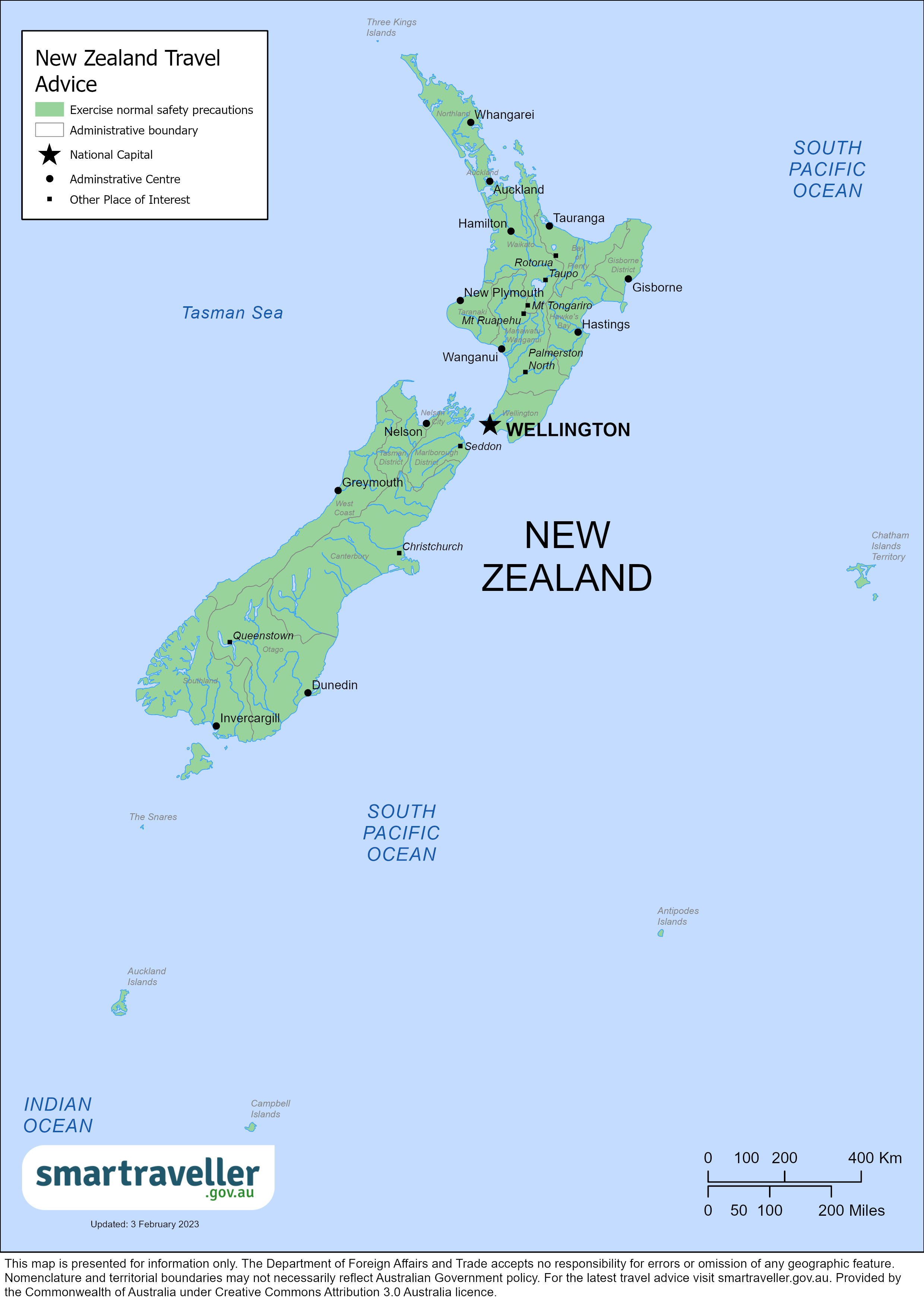
New Zealand (PDF 764.52 KB)
Pacific (PDF 1.27 MB)
Local emergency contacts
Fire and rescue services.
Call 111.
Medical emergencies
Call 111 or contact the nearest police station.
Call 105 or go online for Police non-emergencies.
Advice levels
- The State of Emergency for Wairoa and Heretaunga Ward in Hastings has now ended. Wairoa is entering a local recovery transition period. Check the Hawke’s Bay Emergency Management website for up-to-date information.
- Earthquakes are a constant risk. Large, damaging quakes can happen at any time. Know what to do during and after an earthquake.
- All of New Zealand's coastline is at risk of a tsunami. Know the tsunami warning signs and move to high ground immediately. Don't wait for official alerts.
- New Zealand has several active volcanoes. Volcanic alert levels may rise quickly. You may be ordered to evacuate at short notice. Stay informed and follow the advice of local authorities.
- Weather conditions can change quickly. Severe weather could leave you stranded or injured, especially in an isolated area. If you're climbing, hiking or in a remote area, register your trip with the Department of Conservation. Carry a personal locator beacon.
- Crime rates are similar to those in Australia. Thieves often target vehicles. Don't leave valuables in your car or campervan.
Full travel advice: Safety
- Make sure your vaccinations are up to date before you travel.
Medical facilities and services are of a similar standard to those in Australia.
- New Zealand and Australia have a reciprocal healthcare agreement. This lets Australians access public medical facilities and care. However, there are some things it doesn't cover. Ensure you get comprehensive travel insurance.
Full travel advice: Health
- Don't use or carry illegal drugs. Penalties may include fines and prison sentences, including for small amounts.
- Carry approved identification if you want to purchase alcohol or enter licensed premises. Approved ID includes your passport, a New Zealand driver's licence, an existing Hospitality NZ 18+ Card, or a Kiwi Access Card. An Australian driver's licence is not an approved form of ID under the NZ Sale and Supply of Alcohol Regulations.
Full travel advice: Local laws
You must complete a New Zealand Traveller Declaration Form (NZTD) before passport control on arrival. You need to answer questions about your trip and what you’re bringing into the country. You can complete it online or by using the NZTD app, there's no cost.
- Most Australian citizens don't need a visa to enter unless you have a criminal record or if you've been deported from any country. Entry and exit conditions can change at short notice. You can contact the nearest New Zealand embassy or consulate for the latest details.
- Before you travel, check Immigration New Zealand's website for current entry restrictions and requirements.
Full travel advice: Travel
Local contacts
- The Consular Services Charter details what the Australian Government can and can't do to help you overseas.
- To stay up to date with local information, follow the High Commission’s social media accounts.
For consular help, contact the Australian High Commission in Wellington , or the Australian Consulate-General in Auckland.
Full travel advice: Local contacts
Full advice
Petty crime.
Crime rates in New Zealand are similar to those in Australia.
Thieves often target valuables left in cars and campervans.
Kidnapping can happen anywhere, anytime, including in destinations that are typically at lower risk.
The Australian Government's longstanding policy is that it doesn't make payments or concessions to kidnappers.
More information:
Cyber security
You may be at risk of cyber-based threats during overseas travel to any country. Digital identity theft is a growing concern. Your devices and personal data can be compromised, especially if you’re connecting to Wi-Fi, using or connecting to shared or public computers, or to Bluetooth.
Social media can also be risky in destinations where there are social or political tensions, or laws that may seem unreasonable by Australian standards.
- Cyber security when travelling overseas
Civil unrest and political tension
Demonstrations and protests.
Protests are generally peaceful. However, public protests and events that draw large groups of people can turn violent.
Follow the advice of local authorities.
- Demonstrations and civil unrest
Terrorism is a threat worldwide.
- New Zealand police
- New Zealand Security Intelligence Service
Climate and natural disasters
New Zealand experiences natural disasters and severe weather , including:
- earthquakes
- volcanic activity
- flash flooding
To protect yourself in a natural disaster:
- secure your passport in a safe, waterproof place
- follow the advice of local authorities
- keep in contact with friends and family
Monitor local media and other sources, including:
- Ministry of Civil Defence and Emergency Management
- Global Disaster Alert and Coordination System
- GetReady website (New Zealand government)
Severe weather
The State of Emergency for Wairoa and Heretaunga Ward in Hastings has now ended. Wairoa is entering a local recovery transition period. Check the Hawke’s Bay Emergency Management website for up-to-date information.
Weather conditions can change quickly. Severe weather can occur.
Creeks and rivers can experience flash flooding after heavy rains.
Rapid weather changes could leave you stranded or injured, particularly if you're in a remote area.
Monitor weather conditions, forecasts and warnings from Metservice .
Take extra care if you're climbing, hiking or in a remote area.
Earthquakes
Earthquakes are a constant risk in New Zealand.
Most quakes are too small or deep in the earth to feel. However, about 150 to 200 quakes are big enough to feel each year.
Large, damaging earthquakes have occurred and could happen again at any time. Aftershocks can continue for days or weeks.
When an earthquake happens, you're advised to drop, cover and hold. If an earthquake is long or strong, and you're near the coast or large body of water, you should go to higher ground immediately.
If you're indoors during an earthquake:
- move no more than a few steps to a heavy, solid object you can get underneath, and hold onto it
- don't try to run outside
- stay indoors until the shaking stops
- stay away from windows, chimneys, and shelves with heavy objects
If you're in bed:
- hold onto the bed and stay where you are
- protect your head and body with a pillow and blankets
If you're outdoors:
- move to the nearest clear spot
- keep away from buildings, trees, and power lines
- drop to the ground
If you're in a car:
- drive to a clear place away from buildings, trees, and power lines
- stay in the car with your seatbelt on until the shaking stops
If you're in a lift:
- stop at the nearest floor and get out
After the earthquake finishes:
- be aware of possible tsunami risks (see below)
- prepare for travel delays
- reconfirm your travel arrangements
- check your accommodation with travel agents and tour operators
Because of the region's earthquake risk, tsunamis could happen.
All of New Zealand's coastline is at risk of a tsunami. New Zealand is a member of the Pacific Tsunami Warning System.
The National Emergency Management Agency manages the National Tsunami Advisory and Warning Plan and issues tsunami alerts on its website. These are also broadcast by New Zealand media.
A tsunami could arrive within minutes. There may not be time for an official warning.
Move immediately to high ground, or as far inland as possible, if you're near the coast and you:
- feel a strong earthquake that makes it hard to stand up
- feel a weak, rolling earthquake that lasts a minute or more
- see a sudden rise or fall in sea level
- hear loud and unusual noises from the sea
Don't wait for official warnings.
Walk or bike if possible because of potential road congestion.
New Zealand's active volcanoes can erupt at any time. Volcanic alert levels may rise quickly. You may be ordered to evacuate at short notice.
If there's volcanic activity:
- follow the instructions and advice of local authorities
- follow evacuation orders
- take official warnings seriously
If you plan to visit active volcanoes or surrounding areas:
- monitor the GeoNet website
- get local advice first
Visit GeoNet for information about volcanic activity at:
- Mt Tongariro
- White Island
- other active volcanic sites
Parts of New Zealand experience bushfires in hot, dry conditions.
If there's a bushfire, follow local advice.
Adventure activities
Most people enjoy adventure activities safely in New Zealand. However, these activities carry risks.
Several serious accidents involving Australians and other travellers have occurred. People have died.
Some operators have been found to be negligent.
Safety standards can differ both between individual operators, and from standards in Australia.
If you plan to do an adventure activity:
- be aware of the risks of individual or group activities
- check the safety standards of operators
- check to see if operators meet industry standards
Safety risks can increase in severe weather and remote areas.
Before you do any adventure activities :
- make sure your travel insurance covers your planned activities
- understand what your travel and other insurance doesn't cover
- only book with operators with appropriate safety equipment and practices
- always use the safety equipment, even if others don't
If you're trekking or travelling in a remote area:
- get updates on local weather from the Department of Conservation
- check conditions with the local DOC visitor centre
- register your trip with a DOC visitor centre
- tell your family and friends your plans
- carry a personal locator beacon
- avoid creeks and rivers after heavy rains
You can hire personal locator beacons throughout New Zealand.
When you return from a hike, check in with:
- the DOC visitor centre
- your family and friends
- anyone else who knew your plans
- AdventureSmart
- Mountain Safety Council
Travel insurance
Get comprehensive travel insurance before you leave.
Your policy must cover all overseas medical costs, including medical evacuation. The Australian Government won't pay for these costs.
If you can't afford travel insurance, you can't afford to travel. This applies to everyone, no matter how healthy and fit you are.
If you're not insured, you may have to pay many thousands of dollars up-front for medical care.
- what activities and care your policy covers
- that your insurance covers you for the whole time you'll be away (including if stopovers on the way to your destination are covered)
Physical and mental health
Consider your physical and mental health before you travel, especially if you have an existing medical condition.
See your doctor or travel clinic to:
- have a basic health check-up
- ask if your travel plans may affect your health
- plan any vaccinations you need
Do this at least 8 weeks before you leave.
If you need counselling services in New Zealand, contact:
- Lifeline – 0800 543 354 or free text HELP (4357)
- Suicide Crisis Helpline – 0508 828 865 (0508 TAUTOKO)
- Healthline – 0800 611 116
- Samaritans – 0800 726 666
- General health advice
- Healthy holiday tips (Healthdirect Australia)
Not all medication available over the counter or by prescription in Australia is available in other countries. Some may even be considered illegal or a controlled substance, even if prescribed by an Australian doctor.
If you plan to take medication, check if it's legal in New Zealand. Take enough legal medication for your trip.
Carry a copy of your prescription or a letter from your doctor stating:
- what the medication is
- your required dosage
- that it's for personal use
- New Zealand Customs Service
- Medicare Australia
Health risks
Health risks are broadly similar to those in Australia.
Medical care
Medical facilities, reciprocal health care.
New Zealand and Australia have a reciprocal health care agreement . This lets Australians access public medical facilities and care.
It doesn't:
- include ongoing treatment of existing health conditions
- cover extra accommodation costs or flights for family members
- cover flights to Australia
- replace the need for travel insurance.
To access services under the agreement:
- show your current Australian passport or evidence of permanent residency
- show your valid Medicare card.
- New Zealand Ministry of Health
- Reciprocal health care agreement (Services Australia)
Accident Compensation Corporation
If you're injured in an accident, the Accident Compensation Corporation (ACC) covers the costs of hospital treatment.
The cover provided by ACC:
- offers injury cover on a 'no-fault' basis — this means accident victims don’t have a legal right to sue a third party
- ends once you've left New Zealand
- doesn't replace your need for travel insurance .
You're subject to all local laws and penalties, including those that may appear harsh by Australian standards. Research local laws before travelling.
If you're arrested or jailed, the Australian Government will do what it can to help you under our Consular Services Charter . But we can't get you out of trouble or out of jail.
Penalties for possessing and using drugs may include fines and prison sentences.
- Carrying or using drugs
Alcohol laws
You'll need photo ID to buy alcohol or enter licensed premises.
You can't use your Australian driver's licence.
Approved IDs include:
- current passport
- current New Zealand driver's licence
- Kiwi Access Card
- Approved ID
Quarantine regulations
New Zealand has strict biosecurity rules.
If you don't declare items for quarantine, you'll get an instant fine.
If you make a false statement, you'll face heavy fines and prison sentences.
Customs requirements
When you arrive, customs officers may check electronic devices they suspect are being used in criminal activity. Devices may include:
- mobile phones
- portable tablets
- hard drives
- digital cameras
Australian laws
Some Australian criminal laws still apply when you're overseas. If you break these laws, you may face prosecution in Australia.
- Staying within the law and respecting customs
Dual citizenship
New Zealand recognises dual nationality.
If you're an Australian-New Zealand dual citizen, use your Australian passport to enter and leave Australia.
- Dual nationals
Visas and border measures
Every country or territory decides who can enter or exit through its borders. Make sure you meet all entry and exit conditions. Contact NZ Immigration for details about visas, currency, customs and quarantine rules. If you don't meet the conditions, the Australian Government can't help you.
Visa conditions
Most Australian citizens don’t need a visa to enter unless you have a criminal record or if you've been deported from any country.
Australian permanent residents need to apply online for a New Zealand Electronic Travel Authority (NZeTA) to enter New Zealand. Australian citizens are exempt from this rule.
For more information refer to the NZ Government Immigration website .
If you've been:
- convicted of any crimes, or
- deported from any country
Contact a New Zealand Visa Application Centre for advice well before you travel.
New Zealand Visa Application Centre
Level 6 66 Hunter Street Sydney NSW 2000 Phone: +61 2 8278 4529 or 1800 388 718 Website: www.immigration.govt.nz Email: [email protected]
Border measures
If you are a New Zealand visa or NZeTA holder you still need to complete an NZTD.
For more information see the NZTD website .
Maritime border
New Zealand's maritime border is open to all vessels, including foreign flagged vessels, cruise ships, recreational vessels (such as yachts and small craft) and specialist vessels used in research and exploration.
For more information see the New Zealand Customs Service – Travelling to New Zealand webpage .
- Travelling to New Zealand (New Zealand Government)
- Information for visa holders (New Zealand Immigration)
Some countries won't let you enter unless your passport is valid for 6 months after you plan to leave that country. This can apply even if you're just transiting or stopping over.
New Zealand Immigration requires you to have 3 months of validity on your passport after the date you plan to leave. If you're planning to travel to another destination after leaving New Zealand, you may need more than 3 months validity on your passport after your departure date.
Some foreign governments and airlines apply the rule inconsistently. Travellers can receive conflicting advice from different sources.
You can end up stranded if your passport is not valid for more than 6 months.
The Australian Government does not set these rules. Check your passport's expiry date before you travel. If you're not sure it'll be valid for long enough, consider getting a new passport .
- NZ Immigration
Lost or stolen passport
Your passport is a valuable document. It's attractive to people who may try to use your identity to commit crimes.
Some people may try to trick you into giving them your passport. Always keep it in a safe place.
If your passport is lost or stolen, tell the Australian Government as soon as possible:
- In Australia, contact the Australian Passport Information Service .
- If you're overseas, contact the nearest Australian embassy or consulate .
Passport with ‘X’ gender identifier
Although Australian passports comply with international standards for sex and gender, we can't guarantee that a passport showing 'X' in the sex field will be accepted for entry or transit by another country.
New Zealand Immigration recognises gender 'X' on passports. If in doubt, contact the nearest embassy, high commission or consulate of your destination before you arrive at the border to confirm if authorities will accept passports with 'X' gender markers.
More information:
- LGBTQIA+ travellers
The local currency is the New Zealand Dollar ($NZ).
Declare all amounts over $NZ10,000 or equivalent on arrival and departure. This covers all forms of currency, not only cash.
ATM availability is similar to Australia.
You can use debit or credit cards in most places as you would in Australia.
Contact your bank to let them know you'll use your cards overseas.
Local travel
Driving permit.
You can drive for up to 12 months with your Australian driver's licence.
After that, you'll need to get a local licence.
- Driver licences
Road travel
Ice, snow, fog, high winds and roaming animals can cause hazardous conditions. Heavy rain can cause landslides across roads.
Outside major cities, there aren't many motorways. Overtaking opportunities are limited.
Prepare for longer travel times than in Australia.
Railway crossings don't always have barriers, particularly in country areas.
If you're driving in mountain areas or to ski fields, be aware that roads:
- are often narrow and unpaved
- may not have safety barriers
- may require you to use snow chains
- may only be accessible by 4WD
It’s illegal to use a mobile phone while driving, but there is an exemption for 111 calls in genuine emergencies. Hands-free devices and 2-way radio are permitted.
If you plan to drive in New Zealand:
- learn the local road rules before driving
- be careful if there's ice, snow, fog or high winds
- check for road closures and warnings with the New Zealand Transport Agency
- equip yourself for current and possible weather conditions
- Driving or riding
- Driving in New Zealand
Motorcycles
Make sure your travel insurance covers using a motorbike, quad bike or similar vehicle.
Always wear a helmet.
Taxis and rideshares are generally reliable. The standards are similar to Australia.
The New Zealand Transport Authority regulates taxis and rideshare apps.
Public transport
Buses, trains and ferries operate throughout New Zealand. State-run services are also regulated by the New Zealand Transport Authority.
Take care of your belongings on public transport.
- Transport and getting around safely
Several international cruise lines stopover in New Zealand.
- Going on a cruise
DFAT doesn't provide information on the safety of individual commercial airlines or flight paths.
Check New Zealand's air safety profile with the Aviation Safety Network.
Emergencies
Depending on what you need, contact your:
- family and friends
- travel agent
- insurance provider
Always get a police report when you report a crime.
Your insurer should have a 24-hour emergency number.
Consular contacts
Read the Consular Services Charter for what the Australian Government can and can't do to help you overseas.
Australian High Commission, Wellington
72-76 Hobson Street Thorndon Wellington, New Zealand Phone: +64 4 473 6411 Fax: +64 4 498 7103 Website: newzealand.highcommission.gov.au Facebook: Australia in New Zealand Twitter: @AusHCNZ
Australian Consulate-General
Level 7, HSBC Tower 186-194 Quay Street Auckland City, New Zealand Phone: +64 9 921 8800 Fax: +64 9 921 8820
Check the High Commission website for details about opening hours and any temporary closures.
24-hour Consular Emergency Centre
In a consular emergency, if you can't contact an embassy, call the 24-hour Consular Emergency Centre on:
- +61 2 6261 3305 from overseas
- 1300 555 135 in Australia

Travelling to New Zealand?
Sign up to get the latest travel advice updates..
Be the first to know official government advice when travelling.
Travelling or returning to New Zealand
Passports and visas for entry into new zealand.
- You will need a valid passport .
- If you are not a New Zealand or Australian citizen, you may need to apply for a visa or a New Zealand Electronic Travel Authority (NZeTA) for traveling to or transiting New Zealand.
- Don't forget to check travel requirements for any countries/regions you will pass through in transit and on your return journey.
- All passengers entering New Zealand have the option to complete a New Zealand Traveller Declaration instead of a paper Passenger Arrival Card. Passengers transiting internationally do not need to complete a declaration.
Transit in New Zealand
- If you are not a New Zealand or Australian citizen, you may need to apply for a visa or a New Zealand Electronic Travel Authority (NZeTA) for transiting through New Zealand
- Remember to check your final destination's entry requirements .
- Travellers do not require proof of vaccination or a pre-departure test to enter New Zealand.
- Air New Zealand does not require passengers to provide proof of vaccination or a pre-departure test. We do ask that if you're feeling unwell and test positive for COVID-19, please consider changing your travel plans.

New Zealand
Get ready for mammoth national parks, dynamic Māori culture and world-class surfing and skiing. New Zealand can be mellow or action-packed, but it's always epic.
Best Time to Visit
Best places to visit, attractions, must-see attractions.
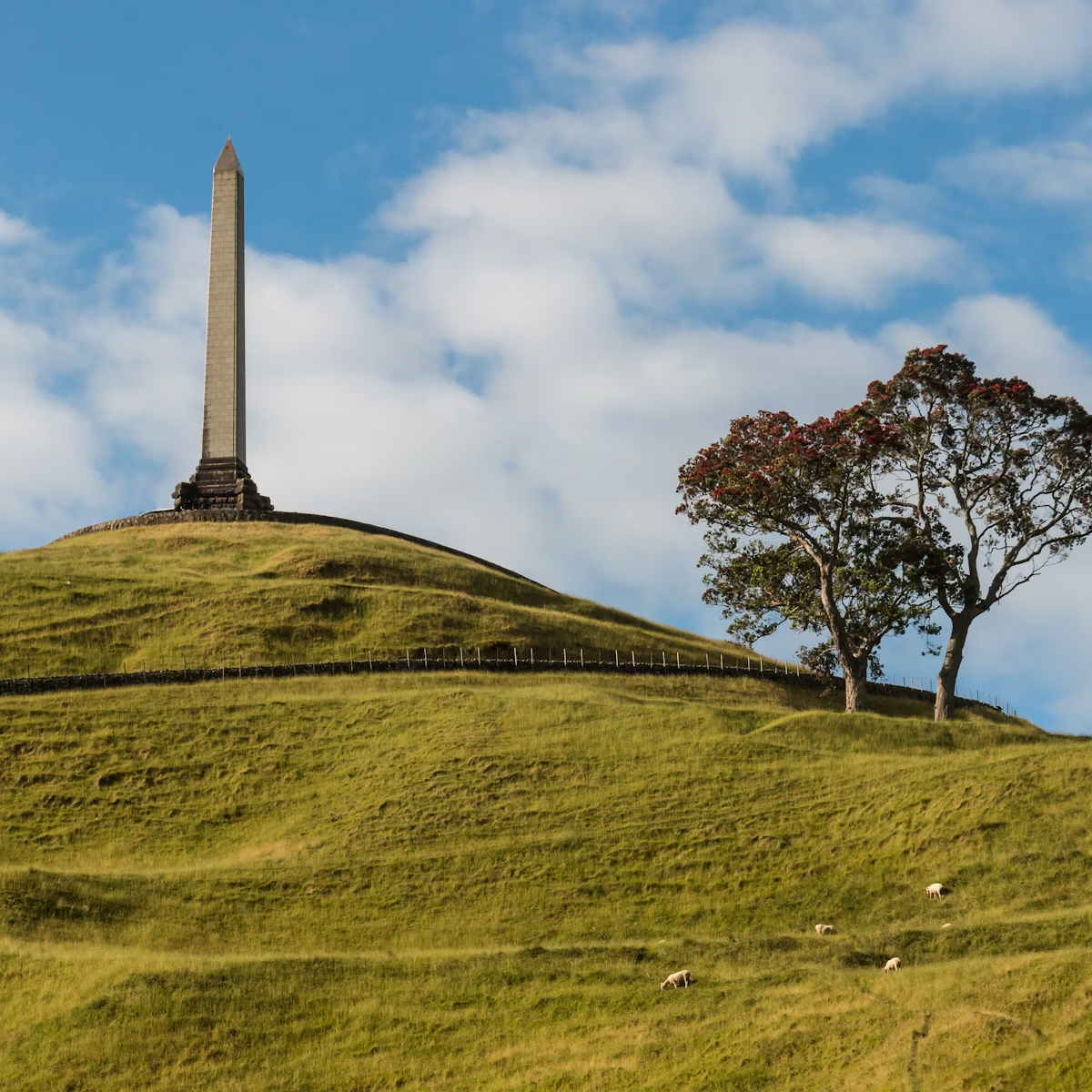
One Tree Hill
Maungakiekie was the largest and most spiritually significant Māori pā (fortified village) prior to British arrival. At the top of this volcanic cone (at…

The Waikato, New Zealand’s longest river, squeezes through a narrow chasm at Huka Falls, making the dramatic 11m drop into a surging crystal-blue…

Slope Point
Fiordland & Southland
South Island’s true southerly point lies not in Bluff, as many mistakenly believe, but at the end of a 20-minute trudge through a windswept cliff-side…

Waitangi Treaty Grounds
Bay of Islands
Occupying a headland draped in lawns and bush, this is NZ's most significant historic site. Here, on 6 February 1840, after much discussion, the first 43…

Te Matua Ngahere
Bay of Islands & Northland
From the Kauri Walks car park, a 20-minute walk leads past the Four Sisters, a graceful stand of four tall trees fused together at the base, to Te Matua…
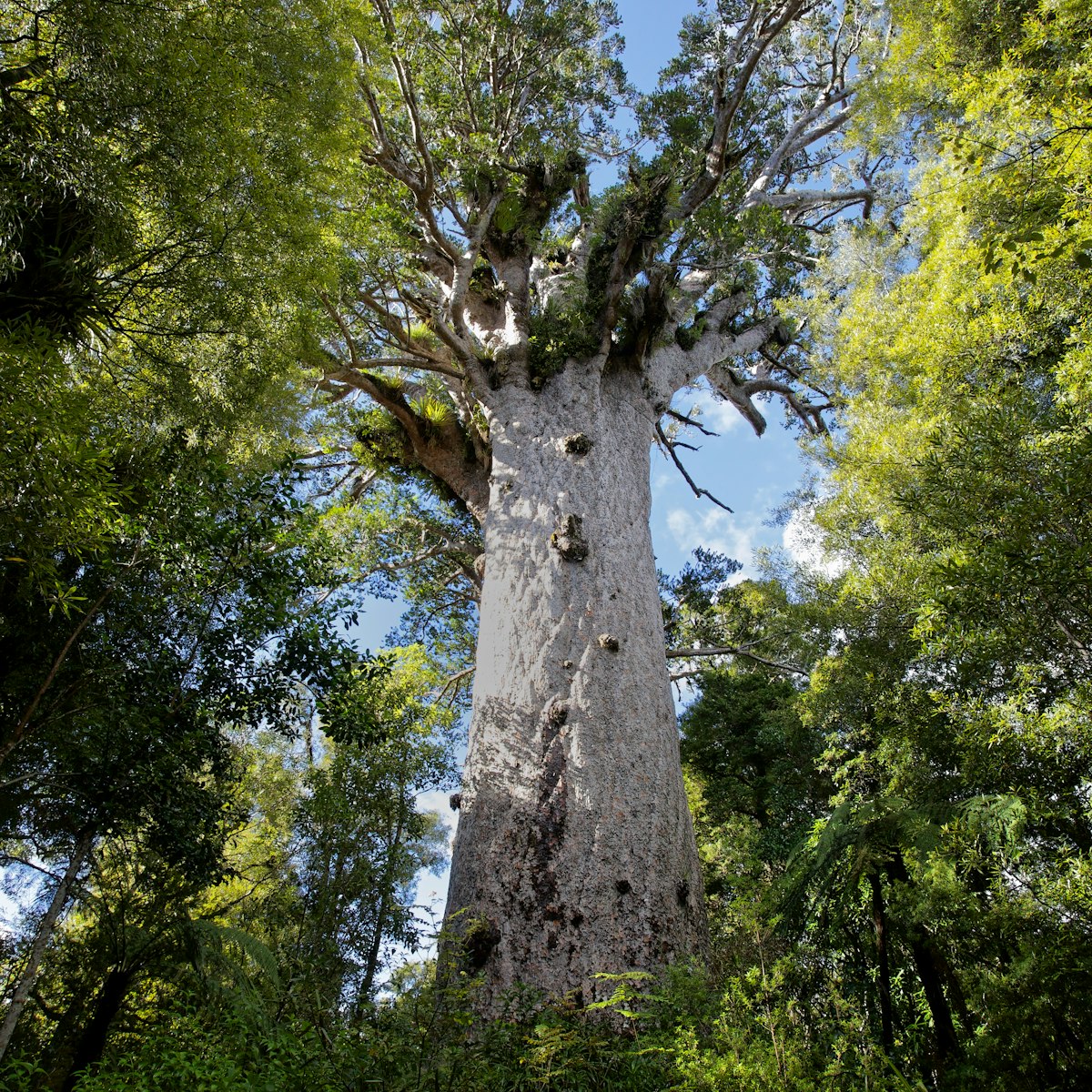
Tāne Mahuta
Near the north end of the park, not far from the road, stands mighty Tāne Mahuta, named for the Māori forest god. At 51.5m, with a 13.8m girth and wood…
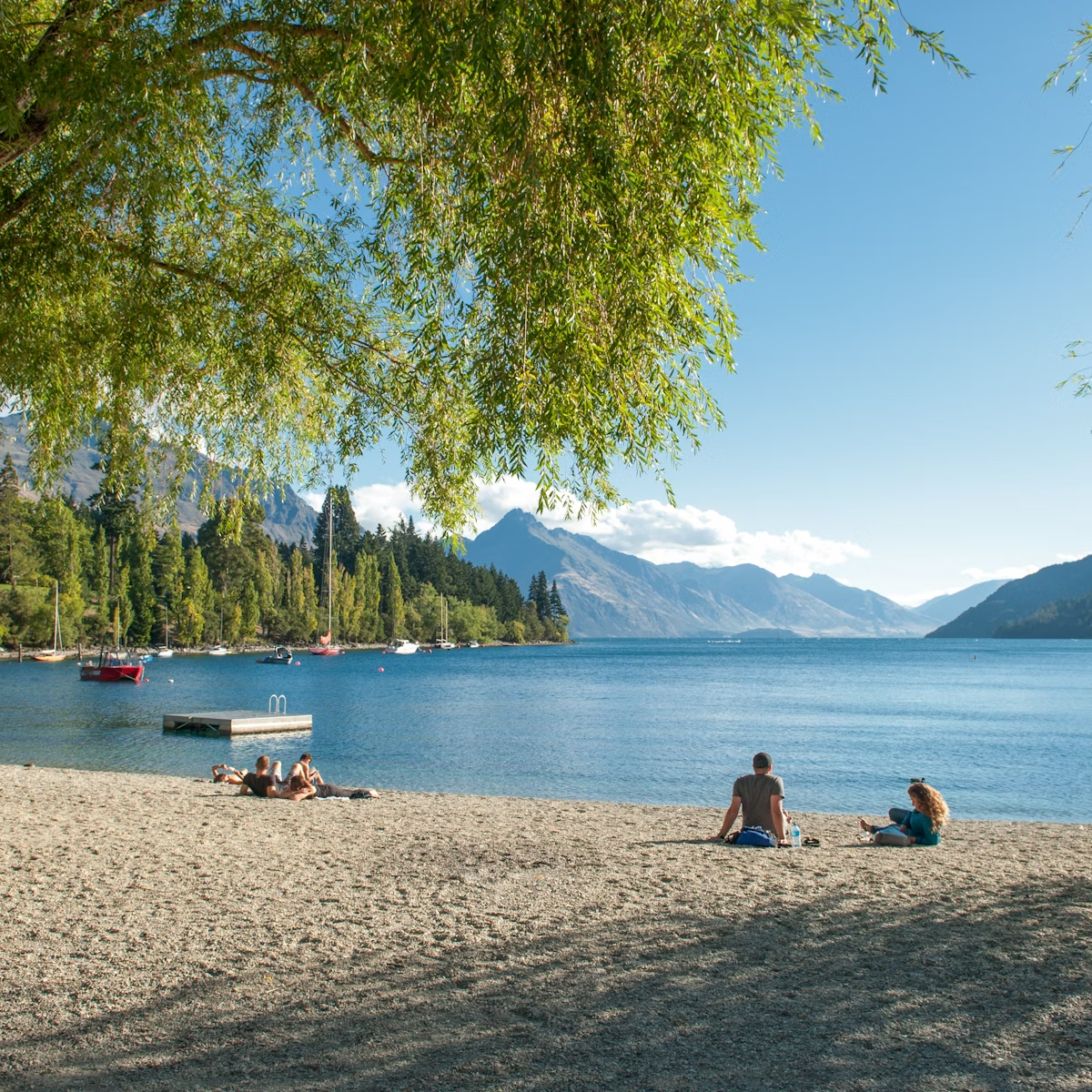
Lake Wakatipu
Shaped like a cartoon lightning bolt, Lake Wakatipu is NZ's third-largest lake. It reaches a depth of 372m, meaning the lake bed actually sits below sea…

Te Puia dials up the heat on Māoritanga (things Māori) with explosive performances from both its cultural troupe and Pōhutu (Big Splash), its famous…
Top picks from our travel experts
10 of the best things to do in new zealand.

Weta Workshop
Academy Award–winning special-effects and props company Weta Workshop has been responsible for bringing the likes of The Lord of the Rings, The Hobbit,…

Otara Flea Market
Held in the car park between the Manukau Polytech and the Ōtara town centre, this market has a palpable Polynesian atmosphere and is good for South…

Kaikōura Seafood BBQ
Conveniently located on the way to the Point Kean Seal Colony, this long-standing roadside barbecue is a great spot to sample local seafood, including…
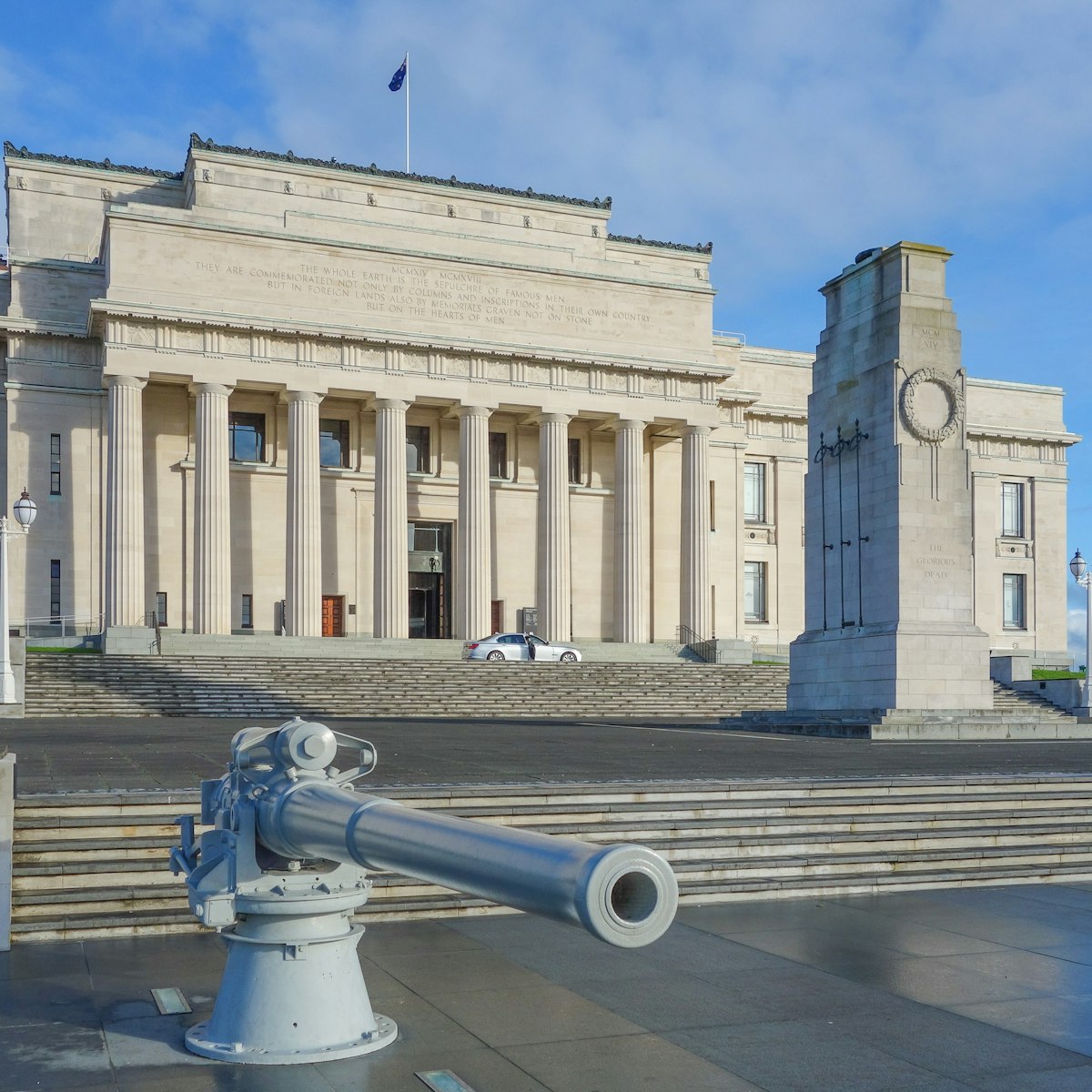
Auckland Museum
Parnell & Newmarket
This imposing neoclassical temple (1929), capped with an impressive copper-and-glass dome (2007), dominates the Auckland Domain and is a prominent part of…

Nin's Bin
This simple caravan 23km north of town sells fresh cooked and uncooked crays (and is an Instagram favourite). Fishing quotas are in place here to protect…

Ulva Island
A tiny paradise covering only 269 hectares, Ulva Island / Te Wharawhara is a great place to see lots of native birds. Established as a bird sanctuary in…
Planning Tools
Expert guidance to help you plan your trip.
Best Things to Do
Experience the very best of New Zealand with this guide to the country's top activities.
Things to Know
To visitors, New Zealand can feel comfortingly familiar and completely strange all at once. Here are some key things to know before you go.
Transportation
Whether you want to explore the cities, escape into nature or have the road trip of your dreams, here are some of the best ways to navigate New Zealand.
Visa Requirements
New Zealand is an incredible country that appears on many travelers' bucket lists. Start planning your trip now with our guide to visa requirements for NZ.
Money and Costs
Affordable travel in New Zealand is possible – if you plan carefully.
Traveling with Kids
With many of New Zealand's major attractions also outdoor activities, it's a great destination for kids.
Best Road Trips
The best way to experience New Zealand is by car or campervan at your own pace, stopping for stunning walks, cycling, wild swimming or wildlife spotting.
Latest stories from New Zealand
Filter by interest:
- All Interests
- Adventure Travel
- Art & Culture
- Beaches, Coasts & Islands
- Food & Drink

Tips & Advice
Jun 20, 2024 • 6 min read
Which of these two wonderful countries should you pick? We asked two writers to make the case for each.

May 20, 2024 • 7 min read

Mar 15, 2024 • 18 min read

Jan 9, 2024 • 6 min read

Jan 2, 2024 • 11 min read

Nov 22, 2023 • 5 min read

Oct 22, 2023 • 7 min read

Oct 22, 2023 • 5 min read

Oct 22, 2023 • 6 min read

Oct 19, 2023 • 8 min read
in partnership with getyourguide
Book popular activities in New Zealand
New zealand and beyond.


Make Your Next Trip Extraordinary
- Middle East
- Australia & Pacific
- Caribbean & Mexico
- South America
- Central America
- Cruises & Yachts
- United States
- About Wendy
- Meet the Team
- Code of Ethics
- How We’re Funded
- How to Support Us
- How You Can Benefit
- Smart Travel in 2024
- Where to Go When
- Family Travel
- Holiday Travel
- Airline Travel
- Cruise Travel
- Our Own Trips
- Ask a Teenager
- Travel Insurance
- Travel Talk Videos
- I Have a Destination
- Tell Me Where to Go
- Just Back: The Latest Reviews
- Anniversary Trips
- Asia WOW Trips
- Christmas/New Year Trips
- Christmas Day Abroad
- Europe in Summer: Beat the Heat
- Europe in Winter: Smart Trip Ideas
- Europe for Winter School Breaks
- Europe’s Secret Spots
- Food-Focused Trips
- Graduation Trips
- Grandparents with Grandkids
- Meeting Noteworthy Locals
- South America WOW Trips
- Speeding Through Airports
- Spring Break Family Trips
- Sporty Adventures
- Study Abroad
- Thanksgiving Trips
- Wildlife Encounters
- WOW Moments
- The WOW List
- WOW List FAQs
- Fees/Pricing Tips
- WOW Moment Rules
Combining New Zealand and Australia: Insider’s Guide to the Best Trip
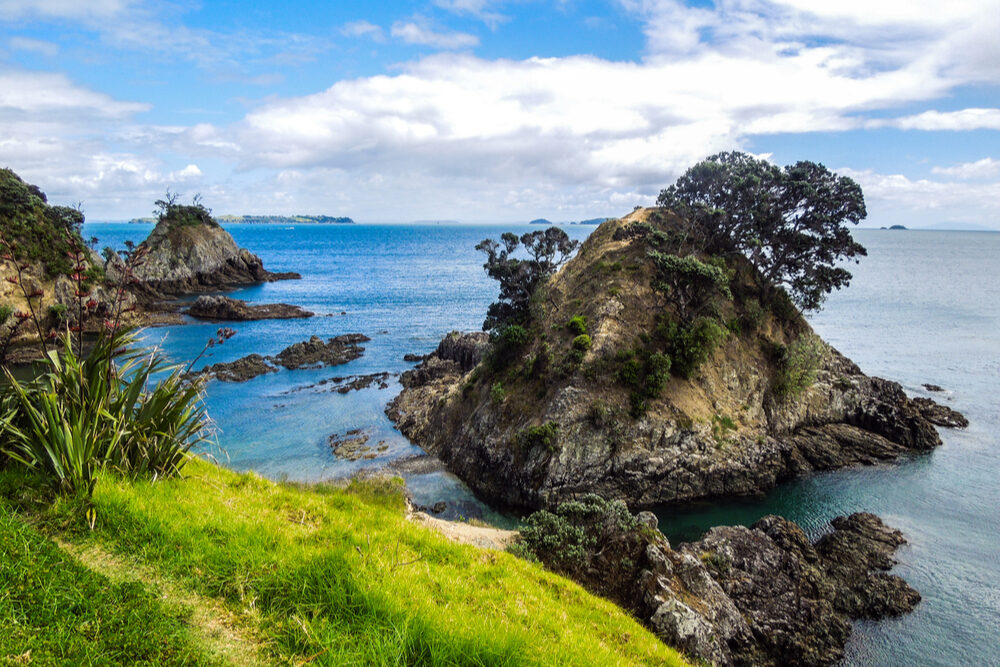
The insider advice on this page is from one of Wendy’s Trusted Travel Experts for New Zealand and Australia: Sarah Farag of Southern Crossings.
A native New Zealander based in Auckland, Sarah works her superb connections—from sheep farmers to helicopter pilots—to open doors for her travelers. She can set you up with a driving itinerary and rental car with stops for scenic hikes, wine tastings, and whatever else you might enjoy, but for those times when you’d prefer not to worry about driving on the left-hand side of the road and to be able to lose your eyes in the country’s countless glorious vistas and navigate to its most charming hidden corners without having to keep your eyes on the road, she has the savviest private drivers at her beck and call. Sarah has pull not just with the country’s top luxury lodges, but also with its guesthouses and even private homes with chefs. And, as a mom of two teenage sons, she is especially tuned in to what families enjoy most. For those wanting to see more of the region, Sarah can add beach stops in Fiji and other South Pacific islands, or coordinate with Sydney-based colleague and fellow WOW Lister Stuart Rigg to include time in Australia.

Tell us about the trip you want
The more detail, the better we can help you..
•What’s your biggest goal for this trip? What would make it most memorable?
- Tell us your trip goals. IMPORTANT: Post-pandemic prices have soared in some countries, so check Wendy’s Pricing Tip: On mobile, scroll down to just above the photo. On desktop, look to the right. *
Getting there and around
Where are you flying from? Have you booked your airline travel? If so, tell us the dates and routing. If not, how long a flight are you comfortable with? Once you’re at your destination, how do you envision exploring it—e.g., rental car? public transit? private vehicle with English-speaking driver or guide/expediter with top connections and special access?
- Tell us your flight dates/route and local transportation preferences (if you know these already). *
Staying there
Do you have a type of accommodations in mind (e.g., 4-star, 5-star, historic inn, state-of-the-art resort, family villa. private yacht, small expedition ship)? Is there a past hotel experience you’re seeking something similar to? If you have already booked accommodations, let us know.
- Tell us about the places you’ve stayed in that you’ve liked, and what you would like now. *
- Estimated Departure Date (Including the Year) *
- Estimated Trip Length (in Days) *
- Total Trip Budget (in U.S. dollars, excluding airfare): * How much do you want to spend for a WOW-caliber trip (incl. rooms, vehicles, excursions, meals, unique experiences, and the savviest drivers/guides/expediters to spare you headaches and wasted time)? Your answer will dictate the locations, trip dates, and experiences we will suggest. Please select (in USD): More than $50K $35,000 to $50,000 $25,000 to $35,000 $20,000 to $25,000 $15,000 to $20,000 $10,000 to $15,000 Other (this choice will open a new box you can write in)
- Tell us about your travel budget *
Where should we send your personalized recommendation?
- First Name *
- Last Name *
- If you’d like this trip to count toward a WOW Moment, use the same email address you’ve used to submit trip requests to WendyPerrin.com in the past. * Enter Email Confirm Email If you’d like this trip to count toward a WOW Moment , use the same email address you’ve used to submit trip requests to WendyPerrin.com in the past.
- Name of travel specialist(s) you've used
- Do you have a WOW Moment certificate you’d like to use? If so, please enter the first four digits of the certificate number. Qualifying rules apply for certificate redemption.
- First 4 digits only
- How did you hear about Wendy? * Please select Condé Nast Traveler Town & Country The Wall Street Journal The New York Times TripAdvisor Friends or colleagues A travel professional Google search Social media I’ve followed Wendy’s advice for years
If you do not receive an email confirmation of your trip request from [email protected] and you have checked your spam folder, let us know: [email protected] .
- Comments This field is for validation purposes and should be left unchanged.
Combining countries
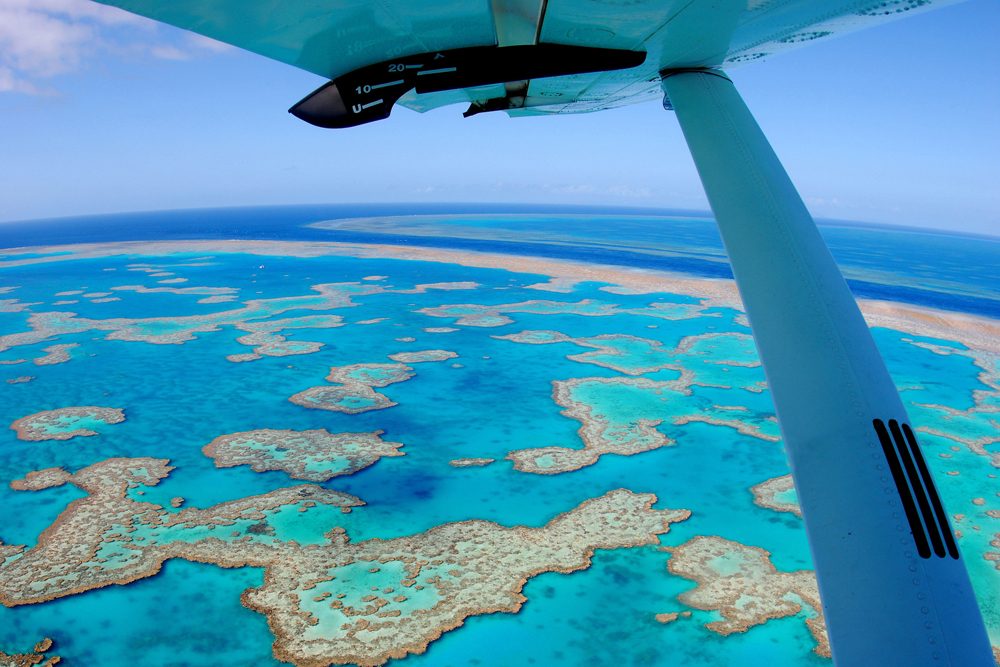
The Great Barrier Reef, seen from above. Photo: Tourism Whitsundays
Always book your trans-Pacific flights into one country and out of the other, so you don’t have to backtrack. It usually makes sense to start with New Zealand: Since you make up time flying from there to Australia and arrive just two hours after you departed, you can still fit a lot into your travel day.
If you have two-and-a-half weeks, you can go wine tasting on New Zealand’s Waiheke Island, explore Maori culture and geothermal features in Rotorua, scratch your adventure itch in Queenstown, enjoy Sydney’s harborside delights, take in Uluru and learn about Aboriginal culture in Australia’s Red Centre, and end your trip on a pristine Queensland beach near the Great Barrier Reef.
Wine lovers will need three weeks to cover the major regions in each country: Waiheke Island, Hawke’s Bay, and Central Otago in New Zealand, and the Barossa Valley, Mornington Peninsula, and Hunter Valley in Australia. Cap it all off with a few nights to detox on an island in the Great Barrier Reef.
Wildlife lovers will need a bit more time to get to the most remote spots. The mountains and rainforests of New Zealand’s South Island hold the last remaining wild populations of most of the country’s bird species, not to mention the marine life hiding along its rocky coastline. Australia’s top nature destinations are spread across the country, from Kangaroo Island in the south to Kakadu National Park in the Northern Territory and Western Australia’s Ningaloo Reef. Hone in on the creatures you most want to see, or expect to spend a good bit of time getting from place to place.
What to Do and See
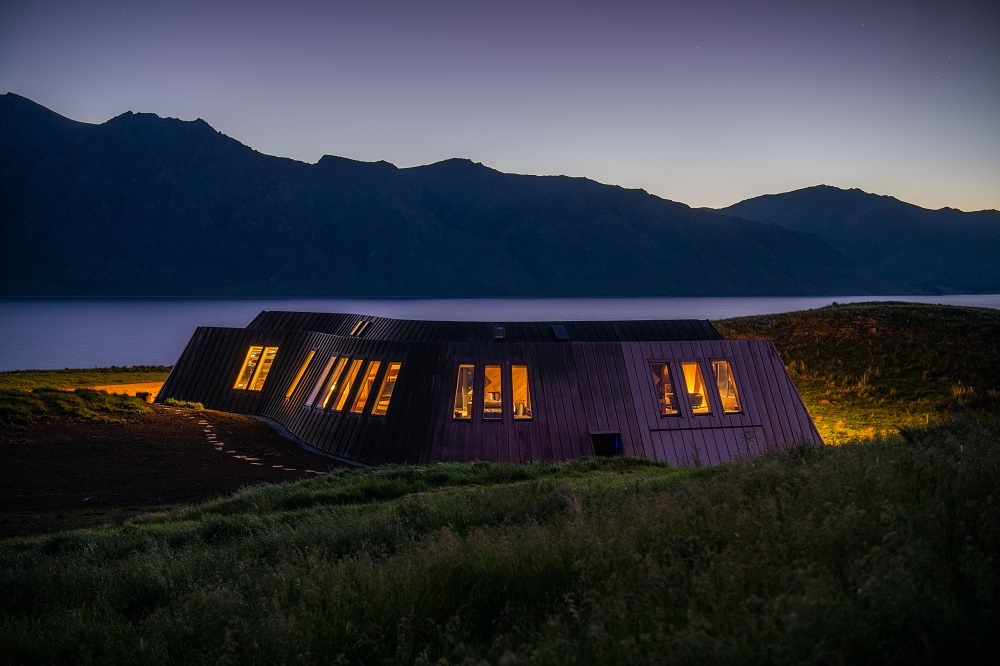
The ultra-luxe Mt Isthmus private villa is near New Zealand’s Lake Hawea, an underrated lake most travelers skip. Photo: The Lindis Group
Most underrated places New Zealand’s Lake Hawea isn’t as well known as Lake Wakatipu in Queenstown, or even neighboring Lake Wanaka. But it’s just as scenically impressive—if not more so—and you are likely to have the vast majority of it to yourself. It’s well worth stopping for a picnic when driving along the country’s west coast, but nowadays you can stay longer thanks to fabulous new options for an overnight, such as the ultra-luxe Mt Isthmus private villa or a cottage on Lake Hawea Station, a sheep and cattle farm focused on regenerative agriculture.
Australia’s Northern Territory can be tricky to work into a multi-country itinerary due to the time required to get there and get around (given the vast distances), but those who make it are treated to red-earth deserts, lush green watering holes, star-filled skies, uniquely Australian wildlife, and authentic Aboriginal experiences.
Most overrated place While Auckland is a thriving city in a beautiful location, New Zealand is all about getting out of the cities. Auckland is also a mini version of Sydney—so if that’s on your list, you can skip the former, or use it only as a base to explore the beautiful islands and beaches on its doorstep.
Hidden gems Both countries are known for their trekking routes, but they’re also a casual walker’s paradise, with countless shorter trails that you can easily enjoy on your own.
Blue Pools Track in New Zealand’s Mt. Aspiring National Park is an easy, three-kilometer track through beautiful beech forests and via an Instagram-worthy swing bridge suspended over the glacial Blue Pools and the Makarora River.
Sydney’s Bronte to Bondi coastal walk is one of the most scenic places to watch the sunrise over the Pacific Ocean and see Sydney locals going about their morning rituals (ocean swims, a before-work surf, beachside yoga, and flat white coffees in a trendy local café).
Don’t bother Hiring a campervan. They have become very overpriced, and now that many parts of both countries have banned “freedom camping”—the ability to park anywhere—they no longer offer the flexibility they once did. Campervans are also not particularly compatible with New Zealand’s winding roads, and many locals are quite opposed to the scenic obstructions when parked en masse in the height of summer.
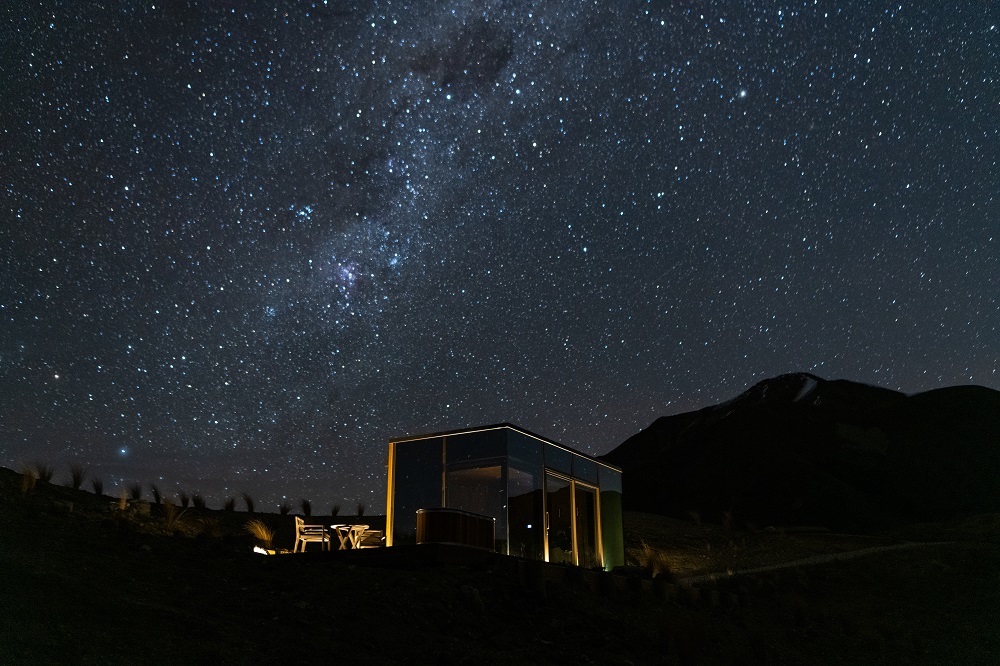
Book one of the glass pods at The Lindis in the Ahuriri Valley and enjoy the twinkling skies from your outdoor hot tub. Photo: The Lindis Group
Cheap thrill There are countless places to enjoy star-studded Southern-Hemisphere skies —from New Zealand’s Southern Alps (the South Island’s Aoraki Mackenzie region is home to an International Dark Sky Reserve) to Australia’s vast outback. Time your stargazing right and you may even catch the spectacular Southern Lights (Aurora Australis).
If “cheap” isn’t a requirement for your stargazing, book one of the glass pods at The Lindis in the Ahuriri Valley and enjoy the twinkling skies from your outdoor hot tub with a flute of New Zealand sparkling wine in hand.
Bragging rights Sarah listens carefully to each traveler’s interests and employs her wide network of contacts to tailor special experiences that you won’t find online. She’s chartered a helicopter and hired a Department of Conservation ranger to take her travelers to parts of New Zealand where few others have ever set foot—including a natural hot springs with a secret location.
In Australia, she’s arranged a birthday party on Shark Island in Sydney Harbour with an Aboriginal welcome and smoking ceremony, didgeridoo players, dinner prepared by one of the city’s most acclaimed chefs, and a private fireworks display.
Prime Picnic Spot Take the ten-minute ferry ride from downtown Auckland across the harbor to historic Devonport . Collect picnic provisions from any of the quaint local cafés before walking up the nearby extinct volcano of Mt. Victoria for panoramic views of the Auckland skyline, the sailboat-filled Waitemata Harbour, and across to volcanic Rangitoto Island.
Across the Tasman, Sydney’s waterfront Botanic Gardens are hard to beat for the picture-perfect picnic spot: a beautiful leafy setting with the harbor, opera house, and bridge as your backdrop.
Where to Stay and Eat
Best bang-for-your-buck hotels Auckland’s Hotel Britomart is the first in the country to earn five green stars from New Zealand’s Green Building Council; it gets another five stars for its service and elegance. All of the rooms are the same extremely compact size—but all exceptionally tasteful and considered—so you’re best off booking one from the least expensive Laneway category.
In Sydney, if your time is short, it’s possible to combine Sydney Harbour views, native Australian wildlife right outside your room, and dinner at one of the city’s hottest new restaurants in a single hotel stay, provided you book a room at the Wildlife Retreat at Taronga , located within Sydney’s Taronga Zoo.
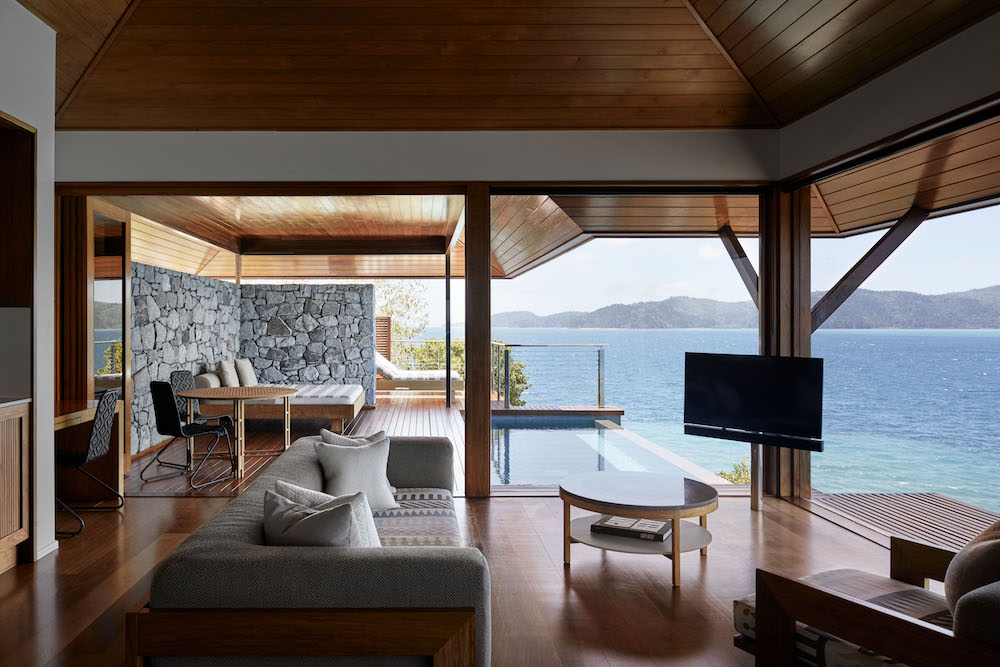
Qualia’s pavilions look out to the Whitsunday Islands, in the Great Barrier Reef of Australia. Photo: qalia
Best-value splurge lodges As accommodations go, New Zealand is best known for its small luxury lodges; one of the most charming is Pihopa Retreat in Nelson. Situated on the outskirts of Nelson, this wonderful boutique property offers six spacious and beautifully appointed suites among 5.5 acres of gardens; continental breakfast is included and dinners can be arranged by the delightful New Zealand owners, who live in the main house with their family.
Ten miles off the coast of Queensland, Australia, Qualia’s 60 ultra-luxe pavilions (what they call their standalone private villas) are nestled into the northern tip of Hamilton Island and surrounded by the Great Barrier Reef. You can fill your days here with snorkeling, scuba diving, flightseeing by helicopter or seaplane, spa treatments, or even a jaunt by private yacht to a secluded beach where you’ll be dropped off with Champagne and a gourmet picnic.
Restaurants the locals love Amisfield is a restaurant and winery on the outskirts of Queenstown, near Lake Hayes. Despite receiving a lot of press after the Duke and Duchess of Cambridge visited in 2014, the bistro’s team have kept their heads down and continue to serve delicious dishes with a lovely local flair—nothing too fancy or fussy, but reliably tasty. The place is always full of locals, which tells you something about its consistency of service and culinary excellence. If you have time for a long and lazy lunch, ask for the “Trust the Chef” option: Simply let them know of any dietary requirements, then sit back, relax, and they’ll bring a selection of dishes to your table.
Fratelli Paradiso is a lively neighborhood trattoria in Sydney’s trendy Potts Point, and a favorite with both locals and in-the-know visiting celebrities; Elton John never fails to enjoy a casual meal here when in town. Friendly waiters translate the blackboard menus as the chefs prepare their signature dishes—Calamari Sant’Andrea and delicious lasagnes—best enjoyed with a glass of wine from the extensive list of Italian and Australian labels. As locals would expect, it’s open seven days a week for all-day dining.
Dish to try Spring is whitebait season in New Zealand, when these tiny freshwater fish become one of the country’s most sought-after delicacies. They aren’t bought in the supermarket; locals have a “whitebait guy” they buy from. The fish are most often cooked with eggs to create omelet-style whitebait fritters, which can be found everywhere from New Zealand’s top restaurants to small roadside takeaway stalls. Four of the six whitebait species are endangered, so ask if what’s being served has been sourced sustainably.
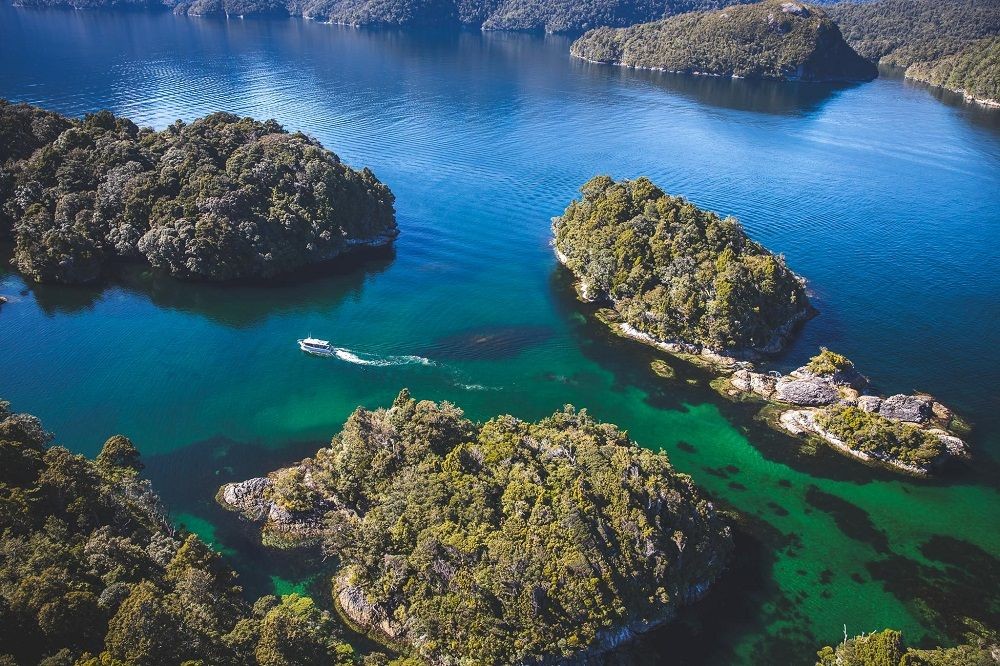
Take a private boat into Dusky Sound, where your pilot will dive into the icy-cold waters for fresh crayfish to barbecue. Photo: Southern Crossings
Meals worth the splurge On New Zealand’s South Island, in a region inscribed as a UNESCO World Heritage site, Sarah can arrange for the ultimate indulgence in both fresh seafood and untouched scenery : A private helicopter takes you on a scenic flight—over rainforests, mountains, glaciers, and fjords—to a custom-built boat in Dusky Sound, one of Fiordland National Park’s most remote inlets. Here you can fish or hike the shoreline where explorer Captain Cook first came ashore in 1773, and where today dolphins, fur seals, and other wildlife abound. For lunch, your pilot will actually dive into the icy-cold waters, harvest a couple of crayfish from the sea floor, and barbecue them to be served with gourmet sides and New Zealand wine and beer.
In Australia’s dining capital of Melbourne, Attica serves innovative degustation menus that showcase local Australian produce such as salted red kangaroo and King George whiting in paperbark, as well as ingredients foraged by head chef Ben Shewry himself.
How to spend a lazy Sunday Farmers markets’ have made a big comeback in recent years and are held in most cities and towns across New Zealand on Sunday mornings. Head down for a delicious brunch freshly harvested by the farmers themselves, and ask the locals which coffee cart is the best. Don’t miss the markets in the waterside precincts of Wynyard Quarter (Auckland), Queens Wharf (Wellington), The Terrace (Christchurch), or Steamer Wharf (Queenstown). In Australia, there is Melbourne’s Queen Victoria Market, the very tasty South Melbourne Market, and Hobart’s lively Farm Gate market.
As for your Sunday afternoon, if you’re in Auckland, catch the ferry across the Waitemata Harbour to Waiheke Island. Known affectionately as the Island of Wine and just 40 minutes from downtown, Waiheke is where locals go for a relaxed vibe, long lunches looking back across to the city, strolls past coastal sculpture, and beach walks.
For a lazy Sunday afternoon in Sydney, catch the ferry across the harbor to Manly , where you can enjoy a coastal stroll, a swim in the surf, and a sundowner with the locals by the water’s edge on Manly Wharf.
Contact Sarah
Not sure if this is the right person for you? Ask Wendy

Get a Personalized Trip Recommendation
For a travel solution tailored to your trip goals and preferences, click this green box.
Best Times to Go
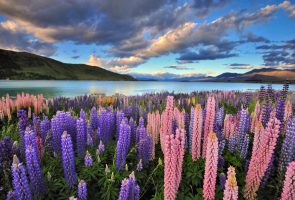
September through May is the best time to combine New Zealand and Australia in a single trip. March and April bring T-shirt days and duvet nights, they’re less crowded than the peak Southern-Hemisphere summer months, and rates are a bit lower.
In October and November the gardens are lush, the countryside is vibrantly green in New Zealand’s North Island and still snow-capped in the South Island, and you get lovely spring weather in Australia.
Worst Times to Go
June, July, and August can get chilly in the region’s southern reaches, and many of New Zealand’s iconic hiking trails close over this period. That said, early August is ideal for heli-skiing and notching untracked runs on private ski fields after the local schools have returned from winter break; you can even combine a New Zealand alpine adventure with Australia’s Great Barrier Reef or a tropical stopover in Fiji.
Biggest Rookie Mistake
Trying to combine Australia and New Zealand in less than two weeks: Most of your time will be spent traveling rather than experiencing. If you can only get away for two weeks, don’t try to cover multiple regions in each country; instead, look at combining Sydney with New Zealand, for example, or Australia with Queenstown.
Can't-Miss Photo Ops
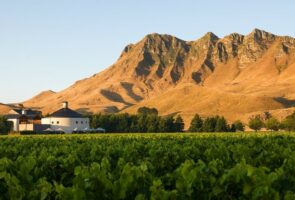
The views are grand at Craggy Range Winery in Hawke’s Bay (pictured), where you can look out over the vines planted at the foot of Te Mata’s dramatic jagged peak; for beautiful light and vines bursting with grapes, get your shot in the late afternoon during the Southern-Hemisphere spring or summer.
The constantly changing hues of Uluru, or Ayers Rock, make it one of Australia’s most iconic photo-ops. Early morning and late afternoon best showcase the colors of this unique monolith—itself a sacred site of the local indigenous people—and the surrounding landscape.
The Souvenirs
Manuka honey, which New Zealand bees produce from the nectar of the native manuka plant. Maori traditionally used manuka for its healing properties, and some people use the honey today for medicinal purposes. In Australia, you can find honey made from eucalyptus, which is prized for is flavor, color, and high quality.
Pounamu, or greenstone, refers to several types of stone found in southern New Zealand that have long been used in carvings done by Maori artists. It is considered bad luck to buy pounamu for yourself, but it makes a wonderfully meaningful gift.
Must-have App
The MetService weather app for New Zealand is handy, with such a changeable climate and so many activities being weather-dependent (although Sarah monitors weather closely for her travelers).
Airport Intel
Auckland International Airport is not physically attached to Auckland Domestic Airport, which makes connecting flights a bit of a headache. While most airlines allow you to book flights with as little as one hour between them, this is almost impossible to make! Two hours is a realistic minimum connection time. For the smoothest logistics, Sarah can arrange for someone to meet you at the plane and for a private car to take you between terminals.
If your U.S.-Australia flights have you changing planes in Auckland, you’ll need to apply for an NZeTa (an Electronic Travel Authority) before you fly.
Do not bring honey or any fresh produce into New Zealand. The country’s unique ecosystem is fiercely protected by its border controllers, who will readily fine anyone bringing in such products.
Tipping Tip
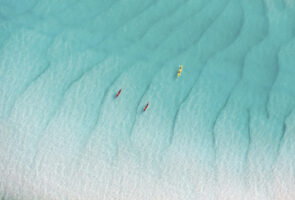
Tipping is not expected in New Zealand or Australia, and is entirely discretionary as an appreciation of good service. All employees are paid full wages and therefore do not depend on gratuities for their income. However, a tip in the vicinity of 10% in recognition of excellent service has become the custom in cafés and restaurants.
Don’t Forget to Pack
Sunglasses and a hat. The sun is strong and the air particularly clear, so these two items are essential year-round.
Think in layers. The weather can change from sunny and hot to cool in a matter of hours, whether you are traveling in summer or winter.
Lots of personal touches...
Glad to be there in the fall..., so valuable to us....
Our Latest Newsletters

Be a Smarter Traveler
Sign up for Wendy Perrin’s newsletter to get essential travel updates and ideas to make your next trip extraordinary.

We may receive a referral fee from trip planners for trips designed for and purchased by travelers referred through us.
- Insider’s Guides to 177 Destinations
- Travel Tips
- Terms of Use
- Privacy Policy

- Where To Go When

Change location
- Call us today from 10am
- 01993 838 925 01993 838 800 or
- REQUEST A QUOTE
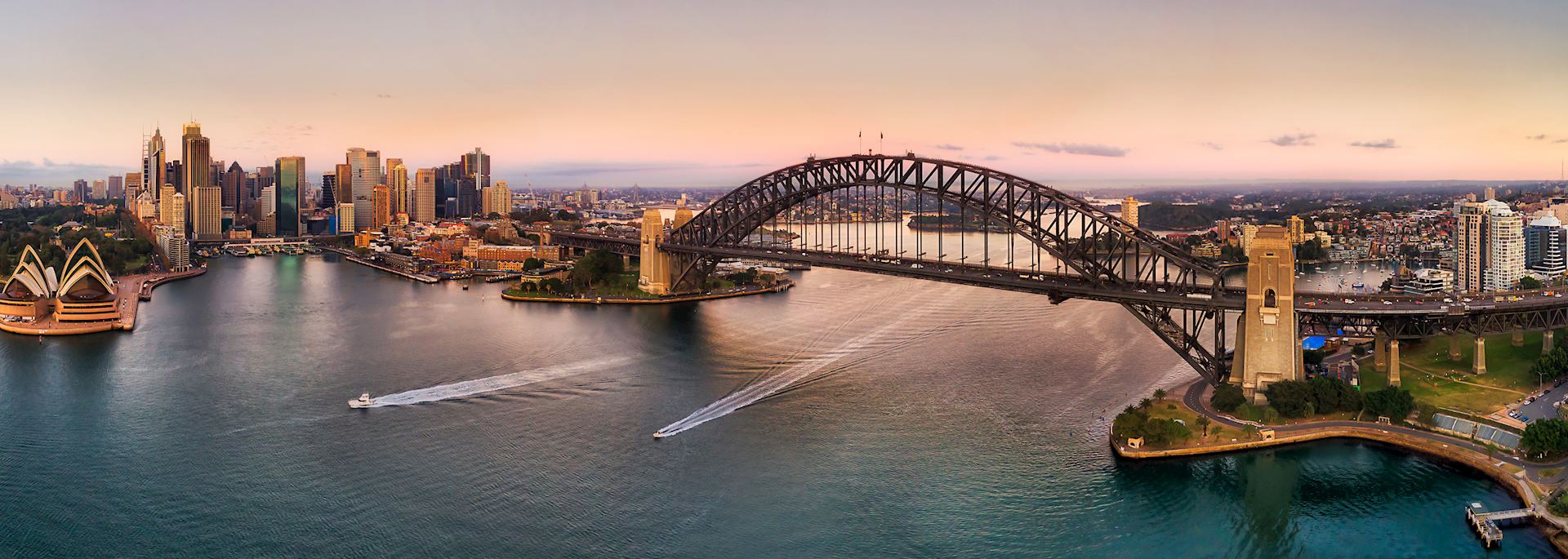
Combining Australia and New Zealand: questions to ask yourself
By Australia and New Zealand specialist James
You could go from the Red Centre’s desert panoramas to tropical Queensland, and follow it all up with the glaciers, sea cliffs and snowy mountain ranges of South Island. Or, embark on a wildlife-themed trip, going from the underwater wonderlands of the Ningaloo or Great Barrier reefs to New Zealand’s Kaikoura, one of the world’s best whale-watching destinations. Combining Australia and New Zealand in the same trip lets you experience wildly contrasting topographies and ecosystems within the space of a few weeks. And, thanks to constantly improving flight connections, it’s easier than ever to travel between the two.
It’s natural you might want to visit Australia and New Zealand in one go: they’re so close, and you’re already taking a long plane journey to get to either place. There are lots of ways to split your time between the two countries — this Australia and New Zealand Uncovered trip outline is just a starting point.
But, for a really fulfilling trip, there are a few things you’ll need to mull over.
How much time do I have?
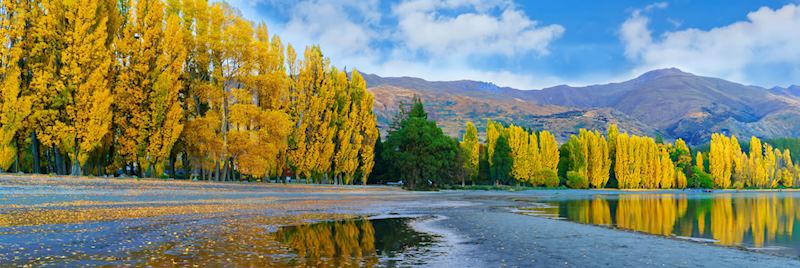
Allow a minimum of three weeks. Any less than that, and I encourage you to focus on only one country.
Five weeks would give you time to see three different areas of Australia without feeling rushed — Sydney, Uluru/Ayers Rock and the Great Barrier Reef is a popular grouping. Then, you could head over to New Zealand for a ten-day road trip through the South Island’s standout scenery.
When do I want to go?
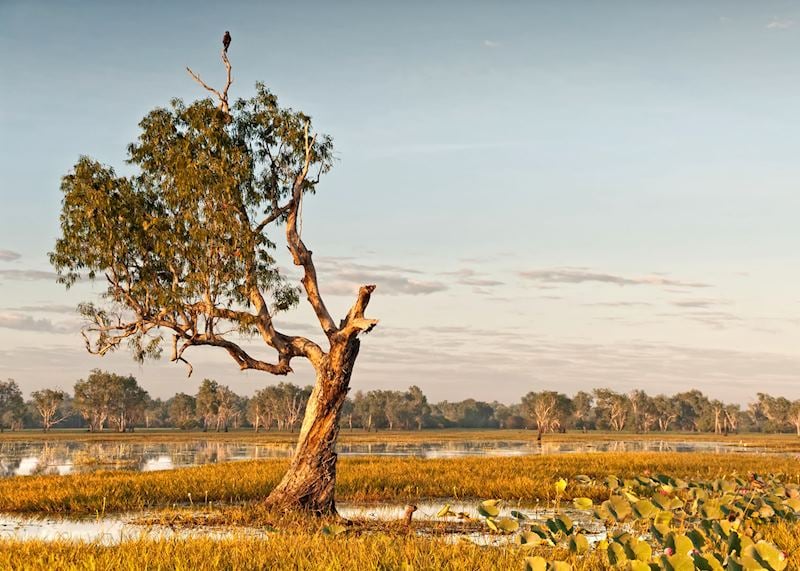
This question determines where exactly you’ll go, so it needs to be considered upfront. It’s really about coordinating the optimum times to go to different areas of Australia with the best time to travel to New Zealand .
I speak to many people who are set on cramming their visit into the Austral summer (December to March), to make the most of the Southern Hemisphere’s warmer weather. This works well for New Zealand, but there are a few caveats for Australia.
Anywhere in Australia south of Brisbane enjoys warm weather and blue skies between December and March. But, this same period coincides with cyclone season in Queensland and the Great Barrier Reef. Visiting over the Christmas period can also rule out Kakadu National Park and the Northern Territory , which gets heavy rainfall at this time of year.
So, if you’re planning to travel between December and March, think about the breadth of what Australia has to offer. The Outback isn’t limited to Australia’s Top End. As long as you’re prepared for the baking sun, you can also experience the Outback in South Australia’s Ikara-Flinders Ranges National Park — a land of clefted sandstone foothills, lonely homesteads, behemoth rock formations and roaming emus.
You can find out more about ‘the Flinders’ (as it’s known) in our guide to South Australia’s landscapes and wildlife . And, as an escape from the Outback’s heat, you could always follow up the Flinders with a few cool glasses of wine in the vineyards of the Clare or Barossa valleys.
If you’re not wedded to a December–March travel period, consider timing your trip for October and November instead. You could catch the tail end of the fine weather in Queensland in October, before moving on to a springtime Sydney. By the time you reach New Zealand in late October to early November, the days will be getting longer and becoming increasingly warmer.
If you want to see Australia’s Top End at its finest, go between May and September, but bear in mind that you’ll have less daylight in New Zealand at this time of year.
How many flights am I prepared to take?
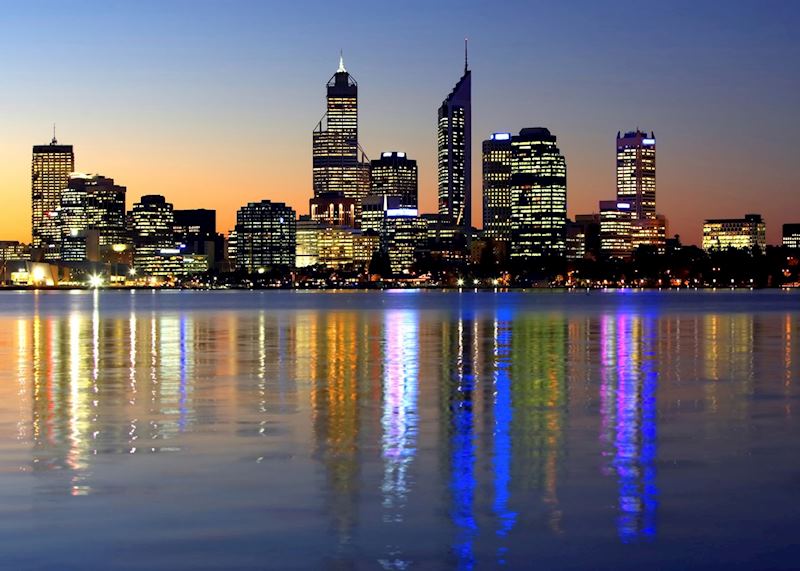
You have lots of options for flying between and Australia and New Zealand. Flight times are relatively short (it’s three hours from Sydney to Auckland , the same amount of time it takes to fly from Sydney to Uluru).
You’re not restricted to the major gateway cities of Auckland, Sydney, Queenstown and Melbourne , either. You could, say, fly from Christchurch to Perth , combining the South Island’s scenic big hitters with time on the beaches and in the winelands of Western Australia’s Margaret River Region.
When combining Australia and New Zealand, I always try to cut down on empty transit time. This can even make you reconsider how much you want to fit in to your trip: how many days do you really want to spend hanging around airports?
You can also break up your flying. You might fly into Sydney, then swing across to Queenstown to start exploring the South Island, before flying to Melbourne to drive the Great Ocean Road . There’s nothing to say you can’t go to Australia twice.
Nor do you have to use Sydney as your starting point. Fly direct to Cairns from Singapore or Hong Kong. Start with the Daintree Rainforest and the Great Barrier Reef, then hop down to Uluru/Ayers Rock, and culminate your Australia leg in Sydney before flying on to New Zealand.
How can I narrow down where I want to go?
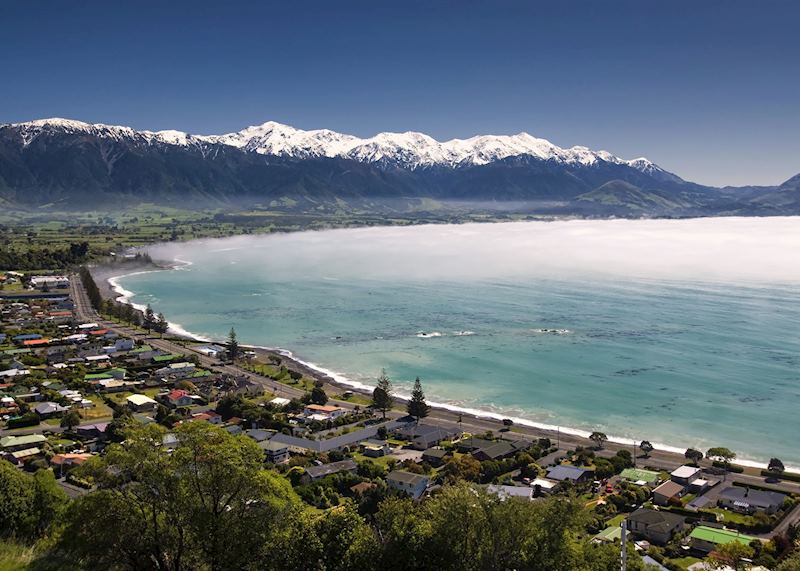
This is a tough one — you have to accept you won’t see everything. Start by thinking about each country in isolation and having an honest conversation with yourself about what you really want to see in each.
As I touched on earlier, the beauty of Australia and New Zealand is that despite their proximity, they’re scenically very distinct. In only a matter of weeks, you can go from shaking the dust off your boots in the Outback to strapping on crampons and walking on a glacier.
If you really don’t know where to start with New Zealand, opt for a classic South Island road trip . This is where you’ll find not only alpine panoramas, winelands and fjords, but also year-round whales, dusky dolphins, fur seals and more in Kaikoura .
With Australia, think about its varying ecosystems and which ones particularly appeal to you. The great knuckle-like, rust-red monolith of Uluru exerts a magnetic pull on some; others are less enthralled. The Great Barrier Reef often sits near the top of many Australia wish lists, but, if you’ve previously visited extensive coral reefs in other parts of the world, you might want to try something new.
When it comes to the cities, I usually argue the case for including Sydney, Melbourne and New Zealand’s capital Wellington . But, in my book, you can skip over Auckland, New Zealand’s biggest city: it shares many of the same characteristics of Sydney (a glittering marina and shiny high-rises). It’s also possible to fly directly from Sydney to Wellington.
However, if you’re an avid birdwatcher, Auckland might come higher up your list. You might, say, be intrigued by the possibility of visiting one of the predator-free island reserves off Auckland’s coast.
If viewing wildlife is important for you, you might wish to spend longer in Australia — New Zealand doesn’t have the standout species nor the zoological variety of Australia.
However, it’s a rewarding destination if you’re especially drawn to marine life or birdlife, as our guide to observing New Zealand’s wildlife explains. There are several places to see the reclusive kiwi, for example, from a hatchery in Rotorua to the untamed Stewart Island in New Zealand’s far south.
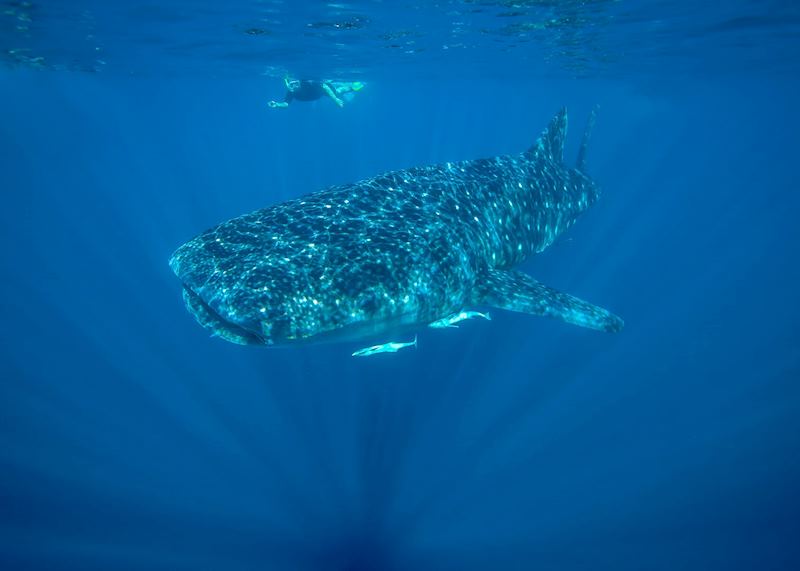
Australia also has much to offer beyond its koalas, kangaroos, and other headline species: the Ningaloo Reef in Western Australia is brimming with sea turtles, reef sharks, and in some places, the rare dugong. And, Kangaroo Island in South Australia is worth the extra journey time. Nicknamed the Australian Galapagos, its wildlife (including echidnas, wallabies and koalas) thrives in the island’s unspoiled environment and the guides here are second to none.
You might also think about not duplicating experiences. If you plan to drive the Great Ocean Road, stopping off at its coves and beaches, perhaps you can afford to forget the beaches of New Zealand’s Coromandel Peninsula.
Instead, think about what can’t be replicated by each country. I’m a fan of the Grampians , a waterfall-sluiced mountain range in Victoria, but they pale into comparison to New Zealand’s Southern Alps or the North Island’s volcanoes.
In short, it’s about combining the best of both places, according to your personal interests.
Finally, try not to do too much. It’s tempting to squeeze as much as you can into a combined Australia and New Zealand trip, but you’ll have a better experience if you’re not just careering around both countries, spending a night here and a night there.
If witnessing the geothermal showground of Rotorua is a priority for you, don’t just limit your experience to one geothermal park. Stay for three days and mountain bike among the spurting fumaroles of Whakarewarewa Forest Park, one of the best places to go cycling in New Zealand . Or, explore the Inferno Crater Lake of the Waimangu Volcanic Valley, which is ringed with a champagne shade of silica terracing.
Similarly, if you’re visiting Uluru, I urge you to escape the crowds thronging Ayers Rock Resort and spend a day visiting Mount Conner, an immense flat-topped monolith set on a private cattle station. It’s the Outback as it was meant to be seen — without another soul in sight. You can find out more about the lure of Mount Conner in our blog about experiences you might not know existed .
Start planning your trip to Australia and New Zealand
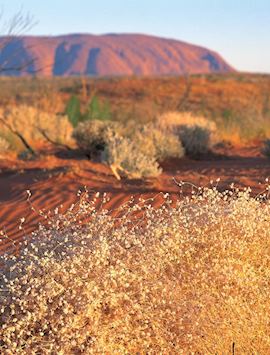
Australia & New Zealand uncovered
23 days from £9,425pp

Sydney to Auckland voyage with Silversea Cruises
24 days from £13,505pp
Start thinking about your experience. These itineraries are simply suggestions for how you could enjoy some of the same experiences as our specialists. They're just for inspiration, because your trip will be created around your particular tastes.
Further reading
- What to do in Australia: our highlights guide
- What to do in New Zealand: our highlights guide
- Self-drive holidays in Australia: beyond the Great Ocean Road
- New Zealand self-drive holidays: 3 great routes
- A world beyond Sydney: 3 road trips around New South Wales
Plan your trip
Tell us about your plans and one of our specialists will plan a unique trip for you...
Request our brochure, The World Your Way

Order your digital copy via email.
- facebook-official
- youtube-play
- pinterest-circled
30 Tips for Travelling in New Zealand 🗺️ [2024]
Nz pocket guide is 10 years old. thank you for trusting us with your trip for over a decade, the ultimate list of new zealand travel tips.
Ah, New Zealand ! Known to the local Māori as “Aotearoa”, New Zealand is a remote country in the South Pacific famous for its dramatic scenery. At about 1,600 km (1,000 mi) long and 450 km (280 mi) at its widest point, the country is easy to explore. And explore you will, with a range of landscapes to entice you, adventure activities to excite you, and friendly locals to guide you. But as is the case with exploring any new country, there are common first-timer pitfalls that may get between you and an idyllic Kiwi getaway. As New Zealand’s largest travel guide, we at NZ Pocket Guide are delighted to make your travels much more seamless with this list of tips for travelling in New Zealand.
1. Plan a Realistic Itinerary
Our first tip for travelling in New Zealand is don’t try to do everything. New Zealand might be a small country but there’s a lot to see, a lot of ground to cover, and a lot of tours and activities. Plan a realistic itinerary that fits your timeframe. If you only have a week in New Zealand , just explore one of the two main islands. We say two weeks is the absolute minimum to enjoy a trip to both the North Island and South Island, but we highly recommend stretching it to three or even four weeks . With New Zealand being far from pretty much everywhere on the planet, it’s a once-in-the-lifetime destination for many. Try to save your New Zealand trip until you have enough time to make the most of it.
For advice on planning your itinerary, see How to Create the Perfect New Zealand Road Trip Itinerary and How to Plan a Trip to New Zealand .
2. Remember to Pay the NZeTA and IVL or Choose a Different Visa
If you’re visiting New Zealand on a Visitor Visa and you come from a Visa-Waiver Country , you are required to have an NZeTA (New Zealand Electronic Travel Authority) as well as pay the IVL (International Visitor Conservation and Tourism Levy) before arriving in New Zealand. You may not have to pay these arrival fees if you are on another type of visa, such as a Work Visa or Student Visa . While we’re on the subject, you might want to look into different visa types if you want to be able to work and stay longer in the country, such as the popular working holiday visa .
For more tips on the arrival fees, check out the 10 Things You Need to Know About the NZETA .
3. Pack Lightly with Versatility in Mind
There is a bit of a misconception that New Zealand isn’t a developed country, but it’s not that bad! You can get a lot of goods and services very easily. With that in mind, you don’t have to pack a ton of food (or any, for that matter), months’ worth of toiletries, nor your whole wardrobe; you can get all that and more in New Zealand. Plus, with New Zealand being a destination where you’re encouraged to explore the country rather than staying in one place, you’ll find that a lighter bag is easier to move between accommodations. On a note about clothing, choose versatile outfits, preferably those to explore the outdoors comfortably. New Zealand tends to have a casual dress code, so there’s no need to pack a ton of different outfits.
For more packing advice, head over to our New Zealand Packing List: What to Pack for New Zealand .
4. Declare!
On the subject of packing, you need to be aware of what not to pack and what to “declare” when arriving in New Zealand . This is because New Zealand has strict biosecurity rules in order to protect its ecosystem. In short, you will be given a New Zealand Traveller Declaration (NZTD) to fill out either online before your flight or on paper during your flight or cruise to New Zealand. Tick the boxes if you have, for instance, any food, sports gear, animal products or plant products packed in your luggage. If you are unsure, just tick the relevant box anyway. You’ll be asked more questions about the answers you give on arrival. Be honest, declare anything you’re unsure of. Otherwise, if you don’t declare something you should have, you could face a NZ$400 fine. Eek!
Get more details using our guide on What Do You Need to Declare When Arriving in New Zealand? and Arriving in New Zealand: Airport Customs, Biosecurity & Arrival Process .
5. Be Aware of All of the Transport Options
Everyone seems to have an opinion on the “best way to travel New Zealand” but choosing the right transport is an extremely personal choice. Travelling by car , campervan , the bus network or a bus tour are the main ways to explore the country, but there are flights , trains and ferries that might be incorporated into your trip too. Start doing your research by checking out our New Zealand transport guides:
- Renting a car/campervan
- Buying a car/campervan
- Buses and bus tours
- Plane, train and ferry .
And if you don’t know where to start, check out our article, What is the Best Way to Get Around New Zealand?
Featured Bus Tour: Backyard Roadies
You can’t get more local than Backyard Roadies who formed out of the pandemic showing locals their awesome New Zealand “backyard”. Well, it’s time to show international travellers the highlights too on their variety of New Zealand tours ranging from 10 to 21 days! To add to the “Kiwi” vibe, Backyard Roadies is not only 100% New Zealand-owned and operated, but they go the extra mile to make their guests feel like locals, spending more time at each destination than most other tours. With small groups and a mix of male and female guides, Backyard Roadies offers fun, safe and great-value tours for all.
Learn more about their tours and become part of the Backyard Roadies family over at backyardroadies.com .
6. Travel in the Shoulder and Low Season
Summer in New Zealand is from December to February , but expect things to get busy from November to March . During this time, flights are more expensive, car rentals are costlier, accommodation books up quickly, attractions are more crowded… With those in mind, we recommend travelling in the low season , from June to August , or better yet, the shoulder seasons from April to May and September to October . The weather is not that bad, just check it out in The New Zealand Seasons and Climate .
For more tips on the best months to travel, see our article on The Best Time to Visit New Zealand .
7. Book Well in Advance if Travelling in Summer
Ok, so for those of you who can’t resist visiting New Zealand when the weather is at its warmest, be sure to do your bookings well in advance. The country goes crazy between the months of December and February so we recommend booking accommodation and vehicle rentals as soon as possible in order to get your first choice. Activities don’t tend to need booking too far in advance, but it doesn’t hurt to be prepared.
For more advice on how to book your trip around New Zealand, head to What You Need to Know About Booking Transport in New Zealand and The Essential Guide to Booking Activities in New Zealand .
8. Travel from South to North
Due to most international flights landing in Auckland , the majority of tourists travel from the North Island to the South Island . The best tip to break away from the crowds and get better deals on transport is to simply travel from south to north! Take a quick flight from Auckland to Queenstown or Christchurch and travel your way back up to Auckland.
Another bonus is for those wanting to rent a vehicle . Car and campervan rental companies have an influx of vehicles being dropped off at their South Island depots, so tend to charge less or even provide more car relocation opportunities with pick-ups in the south and drop-offs in the north.
9. You Can’t Camp Just “Anywhere”
If you plan to stay in a tent or a campervan in New Zealand, be sure to know where you are allowed to camp. Most of the time, you will need to be driving a certified self-contained campervan if you want to park up and stay the night somewhere for free. Otherwise, you will need to stay in campsites and holiday parks . Oh, and you can’t really stay “anywhere” for free, as different regional councils have different laws – see the Freedom Camping Rules in New Zealand: Region by Region . In short, you’ll need to plan where to camp for the night.
For more information, see What it’s Really Like to Freedom Camp in New Zealand .
10. Always Carry an Extra Layer!
New Zealand has a famous phrase to describe the weather: “four seasons in one day.” In other words, the weather changes so rapidly and unexpectedly that you’ll be glad to have an extra layer with you in case it gets cold. We even suggest carrying a rain jacket in your day pack in the likely case that you experience one of New Zealand’s frequent showers. For hikes, you’ll need to take the preparation to the next level, so check out How to Prepare for a Great Walk in New Zealand for tips.
11. There are Only Three Types of ID You Can Use to Prove Your Age
With the legal drinking age being 18 years old, you may need to show your ID to prove your age when buying alcohol. The only forms of ID that are accepted are your passport , a New Zealand driver license and the Hospitality New Zealand 18+ Card . So if you are on a short trip to New Zealand, keep your passport with you for the bar or for buying a bottle of wine from the supermarket. Even if you are actually 30, your ID still might be checked. If you are in New Zealand for a while, keep your passport safe and get yourself an 18+ Card instead.
For more information, see our guide on What ID is Valid for Buying Alcohol in New Zealand?
12. Choose the Right Type of Accommodation for You
Accommodation comes in many forms in New Zealand, which might be different from what you’re used to when travelling. Motels typically consist of self-contained units, while holiday parks are similar but also have campsites and powered sites for campervans. Hostels have private and shared rooms with communal facilities, while hotels offer more premium rooms with facilities such as a restaurant. There are also homestays and holiday homes available. Browse our Accommodation category to see which type of accommodation appeals to you and your budget.
13. Pay in New Zealand Dollars (+ Know About Swedish Rounding)
The currency used in New Zealand is the New Zealand Dollar . You’ll find cheaper currency exchange bureaus in New Zealand’s cities compared to its airports. While cash is accepted everywhere, most vendors also accept Visa and MasterCard . Bonus tip: New Zealanders know “paying with card” as “paying with EFTPOS”. Note that when paying with cash, New Zealand follows Swedish rounding, i.e. rounding prices up or down to the nearest multiple of 10 due to the currency not having any 1, 2 or 5 cent coins.
Get more payment tips in The Best Way to Pay in New Zealand .
14. Know the New Zealand Road Rules
To keep yourself and others on the roads safe, check out the New Zealand road rules before heading out. The obvious thing to remember is that traffic flows on the left in New Zealand, but there are some rules about intersections and one-way bridges that are essential to know. If you are not used to roundabouts, you should also learn how they work. Wise up by checking out our guide on How to Drive in New Zealand .
For more tips on driving in New Zealand, take a look at the 12 Safe Driving Tips for New Zealand .
15. Cyclists, Stick to the Bike Trails
For safety reasons, it’s not recommended for cyclists to travel via the highways in New Zealand. New Zealand drivers are not used to cyclists on the road, so often don’t give enough room when overtaking. On the other hand, the country has a myriad of off-road bike trails of various grades to enjoy car-free cycling. Learn more in our article, Mountain Biking in New Zealand: A Complete Guide .
For cycling rules on the roads, however, check out the City Cycling Rules in New Zealand .
16. New Zealand Might Be More Expensive Than What You’re Used To
Everyday items, such as food and drink, are likely to be more expensive than what you might be used to at home. That’s the downside of being in an isolated country with very little competition. Take a look at the typical prices listed in How Expensive is New Zealand? and plan your budget accordingly.
Check out our tips on how to budget for New Zealand in the 11 Ways to Save Money in New Zealand , as well as How Much Does it Cost to Travel New Zealand?
17. Plan More Travel Time Than What Your GPS Suggests (+ A Warning About Google Maps)
New Zealand’s highways are not multi-lane straight roads (or, at least very few are). Most are single-lane winding roads and some are even gravel, so you’ll unlikely be travelling at 100 kph for the entire journey. For this reason, it usually takes a little longer to cover the same distance in New Zealand than in other countries. Plus, considering that you’re probably going to New Zealand to soak up the scenery and do amazing things, you’ll want to plan some extra time to allow for photo stops. On a similar note, Google Maps is notorious in New Zealand for taking drivers on the shortest route to a destination but not necessarily the easiest. If travelling to a more remote destination, double-check that Google isn’t taking you onto some obscure farm track or logging road.
For more driving tips like this, take a look at our Road Trip Tips category .
18. Come for Nature; Not for Cities
New Zealand does nature so damn well. It’s the home of two UNESCO World Heritage Areas , five International Dark Sky Reserves , 13 National Parks which are free to visit, by the way, and countless other conservation areas. On the other hand, cities in New Zealand don’t offer quite as much and to the same majesty as in other countries, such as Australia. Cities are where people live and work in New Zealand; the wilderness is where people play. The latter is far more interesting.
Add some of New Zealand’s natural attractions to your bucket list using our guide to the Natural Wonders of New Zealand .
19. Protect Yourself from the Sun and the Sandflies
The UV levels in New Zealand are about 40% higher than the same latitudes in North America and Europe. Just seven minutes of sun exposure can leave you with sunburn, while dehydration can come on quickly too. Lather up with at least SPF factor 30 before spending time outside, even when it’s cloudy in summer and even when it’s sunny in winter . Also in summer, sandflies are prolific. Learn how to protect yourself from these insects that leave an itchy bite in the 10 Ways to Stop Sandfly Bites .
For more health tips, check out Health Tips For Travelling in New Zealand .
20. Don’t Underestimate the Amount to Do in New Zealand
Just scroll our 101 Things to Do in New Zealand: The Ultimate List and you’ll get an understanding of the staggering number of things to do. And that list just scratches the surface! Many travellers make the mistake of coming to New Zealand after doing little research and then finding themselves doing impulsive tours and activities in fear of missing out. Stick to your budget and timeframe by doing your research – our Activities category is a good place to start – and being choosy. Make a list of your must-dos!
21. Hiking Will Be Your Best Friend
Don’t be put off by the word “hiking” in New Zealand. The Department of Conservation (DOC) of New Zealand has made it easy with hundreds of easy-to-follow walking trails across the country, ranging from 10 minutes to 10 days! Some trails are stroller and wheelchair-friendly , while others are short and easy for beginners, while more still offer a challenge. Hiking trails are a fun and free way to see many of New Zealand’s top natural attractions and landscapes.
Check out some of the Top 50 Hikes in New Zealand to get an idea of the types of walks available.

22. Know the Difference Between the North Island and the South Island
If it hasn’t been obvious by the time you’ve hit point #22 on this list of tips for travelling in New Zealand, the country is split into two main islands; the North Island and the South Island . Some travellers have to make the tough decision to travel either the North Island or South Island when they are on limited time.
In short, the North Island is where you’ll find the most volcanic activity, Māori culture and cities, while the South Island is where you’ll find snow-capped mountains, glaciers, and, well, scenery, scenery, scenery. Contrary to popular belief, there are some things that you can find on both islands though, like ski fields, glowworms and wineries. Therefore, it’s always worth checking if an activity is available on your chosen island, even if it’s not famous for it.
See our full comparison of New Zealand’s two main islands in Should You Travel the North Island or South Island?
23. Try the Local Cuisine But Also Cook Your Own Meals to Save Money
Of course, you’re travelling in a new country with a new culture and flavours, so you’ll want to eat out in New Zealand to try staples like fish and chips, a Māori hāngī, savoury pies and more . But as discussed earlier in this list of tips for travelling in New Zealand, everyday items like food are expensive, especially in restaurants, cafes and even takeaways. If you’re on a budget , we highly recommend you make at least one meal for yourself per day. Many accommodations have self-catering facilities, as do campervans, so there’s no excuse! Get the lowdown on grocery shopping in New Zealand by following the tips in our guide, Food Shopping in New Zealand .
24. Luxury, Budget, Family, Working Holiday… New Zealand Suits a Range of Travel Styles
There’s room for everyone to enjoy a holiday in New Zealand. Make a luxury getaway by enjoying once-in-a-lifetime bespoke experiences or explore the country extensively by simply doing all of the free things to do ! New Zealand is also extremely family-friendly , while couples on a honeymoon can find many places to get secluded together. Backpacking and doing a gap year on a working holiday are also a top reason to come to New Zealand.
25. Don’t Expect a Good WiFi Connection
New Zealand is a little behind on the times when it comes to accessible WiFi. On the odd occasion when a cafe offers “free WiFi”, it’s usually slow or only for a small amount of data. Accommodations are getting better with offering WiFi, but don’t be surprised if an accommodation advertises free WiFi then gives you a coupon for 20 Mb, i.e. barely enough to email your granny! There are solutions to the WiFi problem, which we offer in How to Get Internet and WiFi in New Zealand , but disconnecting from the world to reconnect with yourself and those around you is not a bad way to experience New Zealand.
26. Tipping is Not Mandatory
Tipping is not common practice in New Zealand, bearing in mind that the minimum wage is quite high so workers’ livelihoods don’t depend on it. If you feel like the service has been exceptional, however, then a tip will always be welcomed.
Need more of an explanation on tipping? See our guide to Tipping in New Zealand .
27. Make Sure You Have the Right Travel Adapter
Ok, so this is a pretty basic travel tip for New Zealand but essential nonetheless. New Zealand’s power outlets use Type 1 three-pin connectors, so get yourself an adapter so you can plug in your electronics from overseas. See our recommendations in the 5 Best Travel Adapters for New Zealand .
28. The Tap Water is Drinkable
Yes, tap water in New Zealand is safe to drink. Many towns even get their tap water fresh from the spring! With that in mind, there’s no need to contribute to the world’s plastic problem by buying bottled water; just refill your reusable water bottle as you go.
29. Don’t Be a D*ck to the Environment
On the same note as the point above, be aware of the extra environmental customs in New Zealand. Otherwise, it just gives tourists a bad name! For instance, clean your shoes properly at cleaning stations to prevent Kauri dieback , keep your distance from seals and penguins , don’t feed kea , etc. Obviously littering is pretty insulting to the environment and the locals so try to avoid that! See the 30 Ways to Travel More Sustainably in New Zealand for more tips for the eco-conscious traveller.
30. Use NZ Pocket Guide
Finally, as New Zealand’s largest travel guide on the web, we’re here for you every step of the way for free! Have a look at our Destinations category for every single city, region and national park to discover.
Our Travel Tips section gives you answers to all those questions you may have about visiting New Zealand, from arrival to departure.
When it comes to filling up your days with exciting experiences, our Activities section is sure to inspire you.
When looking for places to stay, head to our Accommodation section covering all types of stays in New Zealand.
See full sample itineraries completed for you in our Trip Ideas section.
And those staying in New Zealand longer to work or study will find plenty of tips in our Work in NZ category, including job listings .
For a more personal touch, join us for our live Q&A session on YouTube where you can ask us your New Zealand travel questions.
More Tips for Travelling in New Zealand
That’s it for our tips for travelling in New Zealand. For more New Zealand travel tips, check out the following links:
- 30 Tips for Backpacking in New Zealand
- New Zealand Travel Advice: How to Plan a Trip to New Zealand
- The Complete Travel Guide to New Zealand
Happy travels!
The information in this guide has been compiled from our extensive research, travel and experiences across New Zealand and the South Pacific, accumulated over more than a decade of numerous visits to each destination. Additional sources for this guide include the following:
- Tourism New Zealand (General travel advice - Updated [2024])
- Immigration New Zealand (Visa and immigration advice - Updated [2024])
- New Zealand Customs Service (Customs and Biosecurity - Updated [2024])
- New Zealand Traveller Declaration (NZTD online platform - Updated [2024])
- Tiaki Promise (Care for people place and culture - Updated [2024])
- Safe Travel (NZ travel advisories - Updated [2024])
- Stats NZ (Statistics and travel data - Updated [2024])
- Waka Kotahi NZ Transport Agency (Road and transport tips - Updated [2024])
- DriveSafe (Road safety - Updated [2024])
- Council websites and freedom camping maps (Local travel advice region by region - Updated [2024])
- AdventureSmart (Know before you go - Update [2024])
Our editorial standards : At NZ Pocket Guide, we uphold strict editorial standards to ensure accurate and quality content.
About The Author
This article has been reviewed and published by Laura, the editor-in-chief and co-founder of NZ Pocket Guide. Laura is a first-class honours journalism graduate and a travel journalist with expertise in New Zealand and South Pacific tourism for over 10 years. She also runs travel guides for five of the top destinations in the South Pacific and is the co-host of over 250 episodes of the NZ Travel Show on YouTube.
Was this article useful?
Related posts, 8 fun ways to document your travels in new zealand, 11 life hacks to make travelling in new zealand so much easier, 10 ways to meet people when travelling alone in new zealand, sending mail within new zealand, sending mail overseas from new zealand ✉️ [2024], 10 tips to make the most of your gap year in new zealand, recommended for you, how to get wifi in your campervan in new zealand, new zealand working holiday visa: everything you need to know, the top new zealand events & festivals 🙌 [2024], destinations, travel tips, connect with us, accommodation.
Welcome/Kia Ora By using this website you agree to our Privacy Policy and terms of use within it which includes sponsored posts and affiliate links.
Connect with us
Welcome/Kia Ora! By using this website you agree to our Privacy Policy and the terms of use within it.
© 2024 NZ Pocket Guide. Contact – Disclaimer – About Us – Our Standards
- aid.govt.nz
- mfat.govt.nz
- NZ Embassies

Official advice for New Zealanders living and travelling overseas
- Before you go
- Quick checklist and tips
- Disability information
- Dual Citizenship
- Going to Australia?
- LGBTQIA+ travellers
- Staying healthy while travelling
- Passports and visas
- Solo travellers
- Travel insurance
- Travelling with a criminal conviction
- Work and income benefits
- Travel advisories
- By destination
- Central Asia
- Central/South America
- Travel tips - travel to Europe
- Middle East
- North America
- Travel tips - travel to the United States
- South East Asia
- About our advisories
- Travel advisory risk levels
- News features
- When things go wrong
- Arrest and detention
- Contingency planning for New Zealanders overseas
- Financial difficulties
- Hostage taking and kidnapping
- Illness and injury
- Internet dating scams
- Internet fraud and international scams
- Large-scale emergency
- Lost, stolen or damaged passport
- Missing persons
- Nuclear incident
- Victims of crime
- Family issues
- Child abductions
- Combating sex crimes against children
- Inter-country adoptions
- Travelling with children
- Our services
- New Zealand embassy locator
- Travel Advice /
- Section pages:
- Reviewed: 19 May 2023, 14:34 NZST
- Still current at: 6 July 2024
- Get updates by RSS
- Get updates by email
Related news features
- Australia: Bushfires Reviewed: 26 February 2020, 15:30 NZDT
- Brexit: New Zealanders in the United Kingdom Reviewed: 5 February 2020, 15:15 NZDT
- Travelling as a Dual Citizen Reviewed: 21 January 2020, 11:58 NZDT
- View all news
If you are planning international travel at this time, please read our COVID-19 related travel advice here , alongside our destination specific travel advice below.
Exercise normal safety and security precautions
Exercise normal safety and security precautions in Australia (level 1 of 4).
Natural Disasters Australia has experienced an increase in extreme weather events in recent years. We encourage New Zealanders to pay close attention to weather forecasts and warnings. The Bureau of Meteorology provides an app, similar to New Zealand’s Metservice, that we encourage you to download. Australia’s emergency phone number is 000 from a local phone, 112 from a New Zealand/international phone.
We have information about bushfires in Australia here .
Crime The level of crime in Australia is similar to in New Zealand.
Although New Zealanders are not specifically targeted for crime, petty crime such as bag snatching, passport theft and pickpocketing can occur in Australia, particularly in tourist areas. We advise New Zealanders to be alert of their surroundings and take steps to safeguard and secure their personal belongings.
Theft from safety deposit facilities has been known to happen, particularly in cheaper hotels and hostels.
Beware of online letting scams. Scammers have duped tourists into transferring money to an overseas bank account in return for renting accommodation in Australia.
Watch out for drink spiking when consuming alcohol with new acquaintances. Extra care should be taken to ensure your food and drink is never left unattended. We recommend against accepting drinks from strangers or recent acquaintances.
Terrorism New Zealanders travelling and living in Australia are advised to take account of the terrorism threat level assigned by Australian authorities when making travel decisions.
Australia remains a target of terrorist interest, both from international terrorist groups and from domestic-based extremists. Credible intelligence, assessed by Australian security agencies indicates that individuals or groups have both the intent and capability to conduct terrorist attacks in Australia. Attacks could be indiscriminate including places visited by tourists.
New Zealanders in Australia are advised to monitor the media for information about threats to safety and security and follow any instructions issued by local authorities. Remain vigilant about your personal security and take sensible precautions.
General travel advice There is an outbreak of Japanese encephalitis in Australia . Japanese encephalitis is a disease transmitted to humans through the bite of an infected mosquito. The virus is spread when mosquitoes bite an infected animal and the mosquito then bites a human. Infected pigs and some waterbirds are the animals most likely to infect mosquitoes. This poses a particular risk to those visiting places with affected pigs or engaged in outdoor activities areas and exposed to mosquitos. While most infections are asymptomatic or cause mild symptoms, in rare cases it can cause severe disease and death. Given this particular outbreak and the presence of other diseases transmitted by mosquitoes in Australia (such as Barmah Forest virus disease or Ross River virus ), it is important to always protect yourself from mosquito bites. Information on avoiding mosquito bites is available at avoiding bug bites while travelling . Further information on the Japanese Encephalitis outbreak is available on the New Zealand Ministry of Health website . Consult a health care provider or visit a travel health clinic preferably at least 6 weeks before you travel. Your health care provider may discuss the benefits of getting vaccinated for Japanese encephalitis if you are at a higher risk of exposure (e.g. spend a large amount of time outdoors in affected areas).
Australia is home to a number of fascinating yet dangerous animal species. Beware of crocodiles in tropical areas, unless a waterhole overtly permits swimming don’t swim there and observe any shark warnings. Swimming at beaches pose similar risks to New Zealand. Make yourself aware of snake and spider bite protocols.
Like in New Zealand, demonstrations occasionally occur in Australia. New Zealanders in Australia are advised to exercise vigilance around large demonstrations and protests as even those intended as peaceful have the potential to turn violent with little warning.
New Zealanders making short-term visits to Australia are advised to take out a comprehensive travel insurance policy. Make sure this covers you for all activities you plan to do while in Australia.
We have a reciprocal health care agreement with Australia which entitles New Zealand residents to emergency hospital treatment. However, the agreement does not cover out-of-hospital medical treatment including services like ambulances, medical evacuations and elective treatment including doctors' visits.
If you have criminal convictions, you may need to apply for a visa before travelling to Australia.
Criminal record | New Zealand Ministry of Foreign Affairs and Trade (mfat.govt.nz)
New Zealanders planning to live in Australia long-term should see our Going to Australia section, and the New Zealand High Commission to Australia’s Living in Australia section.
New Zealanders travelling or living in Australia are encouraged to register their details with the Ministry of Foreign Affairs and Trade.
Travel tips
- For current health alerts
The New Zealand High Commission Canberra, Australia
Street Address 140 Commonwealth Avenue, Yarralumla, ACT 2600 (visitor entrance on Forster Crescent) Telephone +61 2 6270 4211 Fax +61 2 6273 3194 Email [email protected] Web Site http://www.mfat.govt.nz/australia Hours By appointment only, please call or email.
New Zealand Consulate-General Melbourne, Australia
Street Address Level 4, 45 William Street, Melbourne, VIC 3000, Australia Postal Address PO Box 559, Collins St West VIC 8007 Telephone +61 3 9678 0201 Email [email protected] Web Site https://www.nzte.govt.nz/en/contact-us/australia-pacific/melbourne/#enquiry Hours By appointment only, please call or email.
New Zealand Consulate-General Sydney, Australia
Street Address Level 22, 20 Bond Street, Sydney, 2000, New South Wales Postal Address GPO Box 365, Sydney, NSW 2001 Telephone +61 2 9270 5900 Fax +61 2 9270 5999 Email [email protected] Hours By appointment only, please call or email.
New Zealand Honorary Consulate Western Australia, Australia
Street Address 20 Walters Drive Osborne Park WA 6017 Telephone (08) 9364 1700 Fax (08) 9329 3603 Email [email protected] Hours By appointment only, please call or email.
See our regional advice for Australia
Top of page
Share this page:
Related News features
New zealand high commission australia.
Telephone: +61 2 6270 4211
Fax: +61 2 6273 3194
Email: [email protected]
Website: http://www.mfat.govt.nz/australia
Hours: By appointment only, please call or email.
Related advice from other countries
- United Kingdom
- United States of America
Other pages in this section:
Ministry of Foreign Affairs and Trade 195 Lambton Quay Private Bag 18 901 Wellington 5045 New Zealand
- About this site
- Accessibility
- Before you travel to New Zealand
To board your flight or cruise to New Zealand you need a valid passport or travel document, and have the right visa or an NZeTA.
Your journey to New Zealand
Protect yourself from immigration scams, new zealand electronic travel authority (nzeta), check if you need an nzeta or visa, travellers who do not need an nzeta, arriving by cruise ship, transiting through new zealand to another country, visa waiver countries and territories, transit visa waiver countries, paying the international visitor conservation and tourism levy (ivl).
Arriving in New Zealand
- If you are a premium loyalty programme member
- Visiting New Zealand on business
Checking in for your trip
When you check in you must show that you:
- have a valid passport or travel document, and
- hold the right visa or an NZeTA (New Zealand Electronic Travel Authority).
Check your passport
You may not be allowed to check in if your passport is not valid for travel to New Zealand. Check that it will not expire until:
- 3 months after the date you plan to leave New Zealand, or
- 1 month after the date you plan to leave New Zealand — if your passport was issued by a country that has a New Zealand embassy or consulate that issues passports of that country.
Embassies - Ministry of Foreign Affairs & Trade
If you live in New Zealand permanently — for example, if you have a resident visa — your passport only needs to be valid for travel to New Zealand.
Make sure that your passport has not been:
- reported as lost or stolen, or
- invalidated by the government that issued it.
If you need an NZeTA
You must hold an NZeTA if you are boarding a flight or cruise that leaves for New Zealand, and you:
- are visiting on a passport from a visa waiver country — that is, a country whose passport holders do not need to get a visa before they travel to New Zealand
- are a cruise ship passenger
- are passing through Auckland International Airport to another country and travelling on a passport from a visa waiver country or a transit visa waiver country
- are passing through Auckland International Airport as a transit passenger to or from Australia, or
- have a permanent resident visa for Australia that lets you return to Australia from another country.
If you do not need an NZeTA
You do not need an NZeTA if you:
- hold a visa for New Zealand
- are an Australian or New Zealand citizen travelling on an Australian or New Zealand passport, or
- are a New Zealand citizen travelling on a passport that has a New Zealand citizen endorsement.
Permanent residents of visa waiver countries
Holding a permanent resident visa for a visa waiver country is not evidence of your citizenship.
If you hold a Permanent Resident Card (green card) for the USA (a visa waiver country) you would still need a visa to travel to New Zealand — unless the passport you hold is from a visa waiver country. Your eligibility to travel to New Zealand without a visa depends on the passport that you are travelling on.
If you intend to travel to New Zealand on a passport issued by a visa waiver country you:
- may travel to New Zealand without applying for a visa first
- still must get an NZeTA (New Zealand Electronic Travel Authority) before you travel.
If you are going to travel to New Zealand on a passport from a country not on the visa waiver list, you need a visa before you travel.
Requesting an NZeTA
You request an NZeTA using our mobile app or online form. You may also need to pay an International Visitor Tourism and Conservation Levy (IVL).
Information about NZeTA
Paying the International Visitor Tourism and Conservation Levy
Correct errors on your NZeTA
After your NZeTA is approved, you can only correct some of the details such as your:
- passport number — for example, if you had to replace your passport
- email address, or
- small spelling mistakes or numerical errors.
Use our online form to request these changes to your NZeTA.
How to request a change to your NZeTA
If you want to make other changes, you must request a new NZeTA.
If you have a visa to come to New Zealand
If you have a visa for New Zealand, before you leave, check that:
- your passport details match the details on your eVisa (if you have an eVisa), and
- you have the right visa for what you plan to do in New Zealand.
Contact us immediately if there is an error in the details listed in your eVisa.
If you travel on a different passport
If you do not plan to use the same passport to travel to New Zealand that you used when you applied for your visa, you must apply to transfer your visa to the new passport before you travel. Your visa details are linked to the passport you used to apply so if they do not match, your travel may be delayed.
Transfer your visa to a new passport
I'm a New Zealand citizen but travel on my foreign passport
Check your visa conditions
Check your visa to find out what the conditions are. You may not be allowed to enter New Zealand if you cannot provide evidence that you meet the conditions of your visa. For example, the money you must have to live on in New Zealand can vary depending on the visa you have.
Check the conditions of your visa
Bring evidence to support your travel
Gather the documents you need. Bring with you:
- a copy of your eVisa letter (unless you have a visa label in the passport you are travelling on), and
- evidence that you can meet the conditions of your visa — for example you can use:
- your travel ticket to show that you are planning to leave New Zealand, and
- bank statements to show that you have enough money to live on while you are here.
Do not buy your ticket before we grant you a visa or your application is approved in principle. You may lose the cost of your ticket or have to rearrange your travel if there is a delay in processing your application or we do not grant you a visa.
Checks we need to do
As well as checking your passport and visa, there are other things we need to check.
Before you board your plane or cruise ship
When you check in to travel to New Zealand, we receive information from your airline or cruise line that we use to check our records to make sure you are allowed to travel here.
How we collect and use information about people flying in and out of NZ
We may need to ask you some questions before you board or when you arrive. This applies to everyone, including people who already hold a visa, an NZeTA or are in transit.
Checking your reasons for travelling
As well as checking your passport and visa, we check that you have a genuine reason for coming to New Zealand.
Genuine intentions to visit, study or work in New Zealand
If you do not answer the questions truthfully, you may not be allowed to come here.
If you are refused entry to New Zealand
Onward travel
We may want to see your ticket showing when you will leave New Zealand. We may ask to see other travel tickets or visas if you leave to go to a country that you:
- need to have a visa or onward travel ticket for, or
- are not a citizen of — you need to show that you have the right to enter that country.
We do not need to see this if:
- your eVisa says 'return/onward travel not required'
- your eVisa says 'the holder of this visa is sponsored', or
- you hold a current resident or permanent resident visa for New Zealand.
Supporting yourself in New Zealand
We may want to see evidence of how you will support yourself financially while you are in New Zealand.
Your character
We may want to check that you are of good character and will comply with the conditions of your visa. This could include questions about any convictions you have or whether you have been deported from another country.
Good character for temporary visas
Good character for residence visas
Your health
We may ask for evidence about your health. Before you can enter New Zealand you must be in good health or be granted a medical waiver.
Who needs an x-ray or medical examination
Medical waivers for visa applications
If you are coming to New Zealand on a Medical Treatment Visitor Visa we may ask to see evidence about your health.
Medical Treatment Visitor Visa
Immigration scams to watch out for, and how to protect yourself from these scams and visa fraud.
Some people can use an NZeTA to travel to New Zealand without applying for a visa first. This depends on your passport and if you are visiting or only transiting.
Some people can use an NZeTA to travel to New Zealand, and others need to get a visa.
Visa holders and some other travellers do not need an NZeTA (New Zealand Electronic Travel Authority) before they travel to New Zealand.
If you plan to arrive in New Zealand by cruise ship and do not have a visa, you must hold an NZeTA (New Zealand Electronic Travel Authority).
Check the criteria for a transit passenger, and if you need a transit visa or an NZeTA to pass through New Zealand to another country.
Passport holders of some countries and territories do not have to apply for a visa before they travel to NZ but must hold an NZeTA (New Zealand Electronic Travel Authority).
Citizens of some countries do not have to apply for a visa before passing through New Zealand as a transit passenger but must request an NZeTA.
Many tourists, people on working holidays, and some students and workers coming to New Zealand must pay an International Visitor Conservation and Tourism Levy (IVL) of NZD $35.
What New Zealand's border opening means for citizens, residents and tourists from Australia
New Zealand has announced its plan to "reconnect with the world" over the coming months.
Prime Minister Jacinda Ardern on Thursday announced the country would ease COVID-related border restriction s in five stages, starting from late February.
The plan will reunite families separated by some of the strictest border rules imposed anywhere in the world throughout the pandemic.
It is also hoped that industries like tourism and higher education will receive a must-needed boost from the changes.
So, what does it mean for NZ citizens in Australia?
And what might it mean for trans-Tasman travel going forward?
What have been the restrictions to date?
For the past two years, foreigners have been largely barred from entering NZ altogether, while citizens have had to apply for a spot in hotel quarantine or an emergency exemption.
Spots in so-called managed isolation and quarantine (MIQ) are randomly assigned to only a select number of applicants, leading the opposition Nationals Party to deem it the "lottery of human misery".
The system was last week brought into focus with journalist Charlotte Bellis speaking out against being denied entry to NZ, despite being heavily pregnant.
She was later offered a spot in MIQ via a special exemption, after her predicament made global headlines.
While Australia and New Zealand had established a travel bubble during the pandemic, it has been paused and suspended on numerous occasions due to renewed coronavirus outbreaks.
NZ had previously planned to reopen for quarantine-free international travel in mid-January, but delayed the move due to the spread of the Omicron variant overseas.
Now, with some 94 per cent of NZ's eligible population having received two doses of the vaccine, the government will allow thousands of stranded Kiwis to return home.
What's going to happen and when?
Fully vaccinated New Zealand citizens and visa holders from Australia will be allowed to enter starting from 11.59pm on February 27.
They will be required to self-isolate for 10 days.
"New Zealanders from Australia are coming home on February 27 and all planning heads towards that," Ms Ardern said.
From March 14 onwards, vaccinated New Zealanders and residents from the rest of the world will also be allowed to self-isolate.
Partners and dependents of NZ citizens and residents will also be allowed to enter, as will those participating in working holiday schemes and some skilled workers.
Offshore temporary visa holders elsewhere in the world and up to 5,000 international students will then be allowed in from April 13.
But it might not be until July that all Australians, including tourists, will be allowed to return to New Zealand.
"We anticipate this stage will begin no later than July. I want to place strong emphasis on this being the latest we expect this to begin," Ms Ardern said.
"There is a high likelihood of this date coming forward as we progress through the next stage of the pandemic."
All other international visitors will be allowed to enter New Zealand from October.
MIQ will remain mandatory for travellers deemed "high-risk" by the government, including those who are unvaccinated.
Unvaccinated travellers will find it difficult to get to NZ in the first place given vaccine mandates imposed by Air New Zealand, Qantas, Virgin Australia and other airlines.
NZ armed forces personnel will begin the process of withdrawing form MIQ, with Ms Ardern adding that some hotels would return "to traditional use to support the return of our tourists".
What does this mean for Kiwis in Australia?
It has major implications for the hundreds of thousands of NZ citizens living overseas, including in Australia.
Pre-COVID, Australia and New Zealand citizens had enjoyed free movement between the two countries since the 1920s.
As of mid-2018, there were an estimated 568,0000 New Zealand-born people residing in Australia — representing the fourth-largest migrant community.
Christel Broederlow lives on the Gold Coast and runs a Facebook group for the Māori community living in Australia.
She said Thursday's announcement had been met by New Zealanders in Australia with "elation", but that many remained anxious the situation could change again at short notice.
Many New Zealanders were desperate to return because they have lost their jobs in Australia during the pandemic, she said, adding that many aren't eligible for government assistance because they have not been in Australia long enough.
"It's it leaves them stranded, a lot of them that sold everything, that sold their homes and their flights only for New Zealand government to announce their postponement."
In 2020, Ms Broederlow and her husband had planned to move back to New Zealand to be closer to her ageing father, but their plans were ruined by the border closures.
Despite Ms Broederlow's father since being diagnosed with lung cancer, she has not been able to visit NZ.
"I believe the New Zealand government hasn't seriously considered the health and wellbeing, or mental wellbeing of the people — New Zealand citizens — that have been left stranded in Australia and also the world."
Melbourne-based Martin Newell's mother was recently hospitalised for heart failure in NZ.
"That was exceptionally stressful, not just being able to jump on a plane and be with her," he told the ABC.
What might the economic impact be?
Tourism was New Zealand's largest export industry and a huge proportion of their tourists were Australian before the pandemic hit.
Almost one in 10 New Zealanders were directly employed in tourism.
There were 1.5 million arrivals from Australia — accounting for 40 per cent of international visitors to NZ in 2019 — who spent some $NZ2.7 billion ($2.5 billion).
And it goes both ways.
New Zealanders were the second largest market for visitor arrivals into Australia in 2019.
Daniel Gschwind, head of the Queensland Tourism Industry Council, welcomed the planned relaxation of NZ's border rules.
"It's really important for our industry, and I would think for many families spread across the ditch here, it's very important to get our connection going again," he said.
"We're practically one market. New Zealand is often treated as almost part of our domestic network.
"It is quite, almost bizarre, that we're cut off from New Zealand while we engage with the rest of the world," Mr Gschwind said.
In a statement, Tourism Industry Aotearoa welcomed the the announcements but said the government must be prepared to remove self-isolation requirements as soon as health risks eased.
Spokesperson Ann-Marie Johnson said New Zealand remained off the radar for international travellers while the requirements were in place.
“The need for self-isolation is questionable, especially if Omicron becomes endemic in the community as modelling suggests," she said.
"With risks equalised between New Zealand and overseas, the rationale for keeping self-isolation rules in place no longer exists."
A survey by Tourism New Zealand in mid-2021 showed that more than 80 per cent of Australians actively considering travel to the country were wanting to do so for a holiday, while 21 per cent intended to visit family.
"I would so like to go home and hug my dad and you know, see how he is face-to-face," Ms Broederlow said, adding though that she was not rushing to book plane tickets because they are anxious about the possibility of getting stuck in NZ.
The country faces a growing Omicron outbreak — although small compared to Australia's — with 147 new COVID cases reported on Thursday.
Spread of the virus is expected to continue as more international travellers arrive.
Ms Broederlow and her husband have decided to remain based in Australia for fear of being separated from their sons and other family here in the future.
"There's just too much uncertainty and it's gonna take a long time to revive the crippled tourism between the countries and economies," she said.
- X (formerly Twitter)
Related Stories
Kiwis in australia can return home this month, tourists to be allowed back in 'no later than july'.
Pregnant New Zealand journalist Charlotte Bellis offered a way home from Afghanistan with place in hotel quarantine
- Immigration Policy
- New Zealand
- Travel and Tourism (Lifestyle and Leisure)
- Vaccines and Immunity
7 Best Australia & New Zealand Itineraries
Customers rate Zicasso's travel referral service 4.9 on a scale of 1 to 5 based on 1559 reviews on Trustpilot
We match you with top tour companies that specialize in the trip you want, whether it's a customized private tour or a group tour.
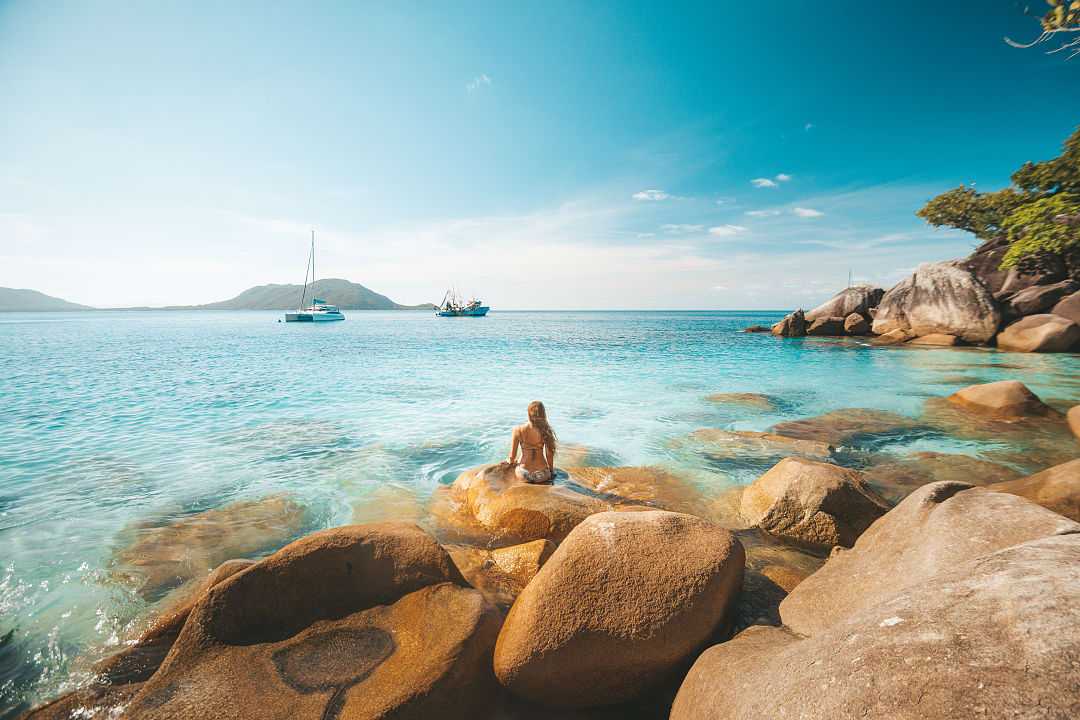
Fitzroy Island, Australia
From the rugged Outback and iconic Uluru to the vibrant Great Barrier Reef, the dramatic fjords of Milford Sound, and rich Māori traditions, our best Australia and New Zealand itineraries offer an incredible array of natural wonders, indigenous cultures, and unique experiences for you to enjoy.
Whether you're an outdoor enthusiast, a culture vulture, a wildlife aficionado, or a discerning traveler seeking luxury and adventure, our tours are carefully crafted to a wide range of interests and personalized to connect to your specific preferences.
Find inspiration for your epic journey, which will unveil the mesmerizing color changes of Uluru, the vibrant marine life of the Great Barrier Reef, or the rich indigenous heritage for which these countries are known.
1. Oceania Trip of a Lifetime: Best Australia & New Zealand Tour
2. epic highlights tour of australia & new zealand, 3. an intimate wildlife tour of australia & new zealand, 4. photography expedition tour to australia & new zealand, 5. a romantic getaway tour to new zealand & australia, 6. new zealand & australia tour for families with teenagers, 7. an eclectic australia & new zealand tour: nature, culture, & gastronomy, plan your australia & new zealand trip with a destination expert.
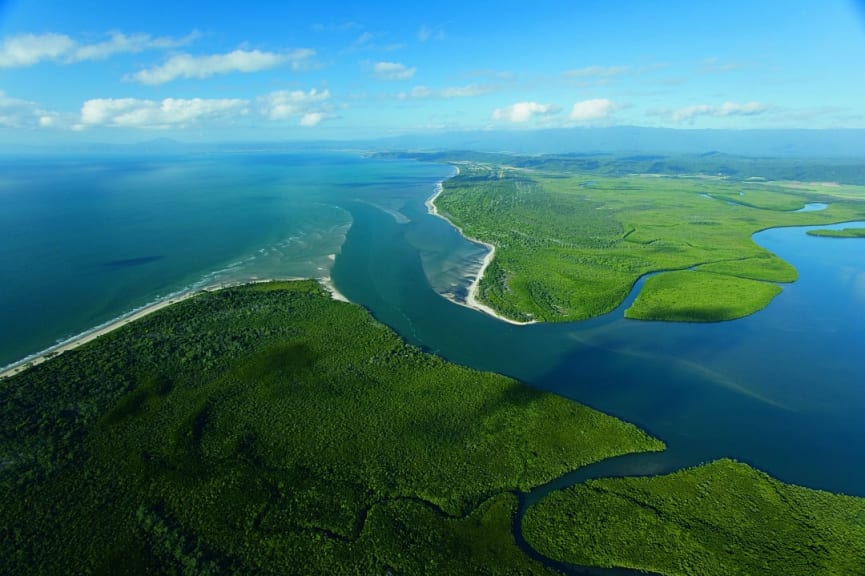
Photo © Tourism Port Douglas and Daintree
Length: 22 Days
Places Visited: Sydney, Melbourne, Kata Tjuta, Uluru (Ayers Rock), Daintree National Rainforest, Port Douglas, Queenstown, Milford Sound, Franz Josef, Christchurch, Rotorua, Auckland, Waiheke Island, Waitomo
Why we recommend this sample itinerary:
On our Oceania Trip of a Lifetime: Best Australia and New Zealand Tour , you will be treated to an unparalleled luxury experience that showcases the diverse natural wonders and rich cultural heritage of Australia and New Zealand.
Whether a discerning traveler looking for an immersive and comprehensive experience of natural wonders or eager to take part in rich cultural heritage, you can witness mesmerizing Uluru, snorkel the vibrant Great Barrier Reef, or enjoy Australia's iconic Outback and tropical landscapes. In New Zealand, behold the spectacular scenery of Milford Sound's fjords, take a helicopter tour over Franz Josef Glacier, and walk through ancient rainforests to learn about Māori traditions.
Expert Tips for Discerning Travelers
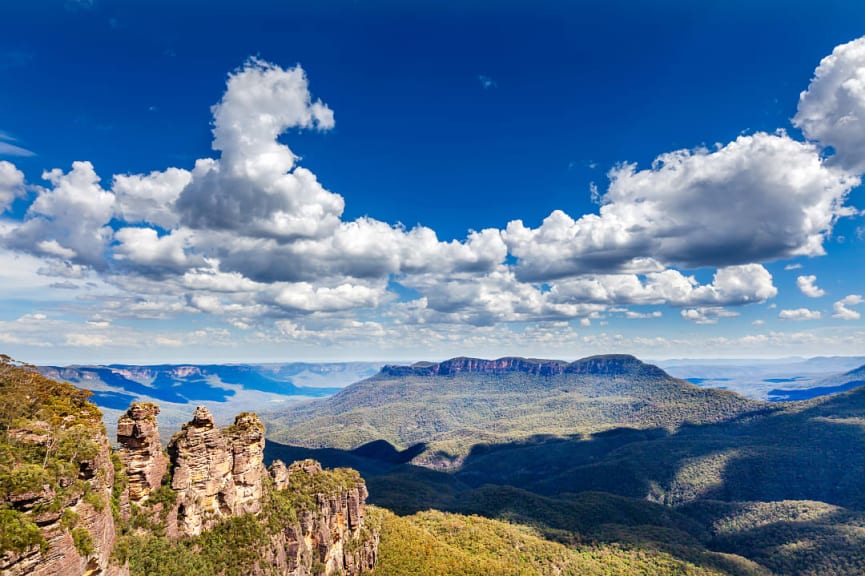
The Three Sisters rock formation in Blue Mountains National Park, Australia
Length: 20 Days
Places Visited: Sydney, Uluru (Ayers Rock) & Kata, Cairns, Port Douglas, Melbourne, Phillip Island, Queenstown, Milford Sound, Rotorua, Waitomo, Auckland, Waiheke Island
The Epic Highlights Tour of Australia and New Zealand will propel you into stunning natural landscapes and rich cultural heritage. In Australia, witness mystical Uluru, snorkel the Great Barrier Reef, and learn about Aboriginal Dreamtime legends, while New Zealand promises to wow you with Milford Sound’s dramatic scenery, a helicopter flight over Franz Josef Glacier, and opportunities to connect with Māori traditions.
Embark on a luxurious adventure with cultural experiences and stunning natural scenery as you explore the breathtaking outdoors coupled with exclusive accommodations and unforgettable experiences, from sailing Sydney Harbour to enjoying an effortless journey through massive caves. Revel in immersive cultural encounters and up-close adventures in striking natural wonderlands.

Length: 18 Days
Places Visited: Melbourne, Kangaroo Island, Uluru, Cairns, Auckland, Wellington, Kaikoura, Stewart Island
An Intimate Wildlife Tour of Australia and New Zealand provides passionate wildlife enthusiasts, nature lovers, and adventurous travelers with the opportunity to experience incredible wildlife. Get up close with kangaroos and koalas on Kangaroo Island, snorkel the colorful Great Barrier Reef, take a hot-air balloon ride over Uluru, and spot rare kiwis on Stewart Island.
From the Outback to lush rainforests and marine wonderlands, you will be immersed in diverse landscapes with expert naturalist guides as you uncover the South Pacific’s remarkable natural treasures.
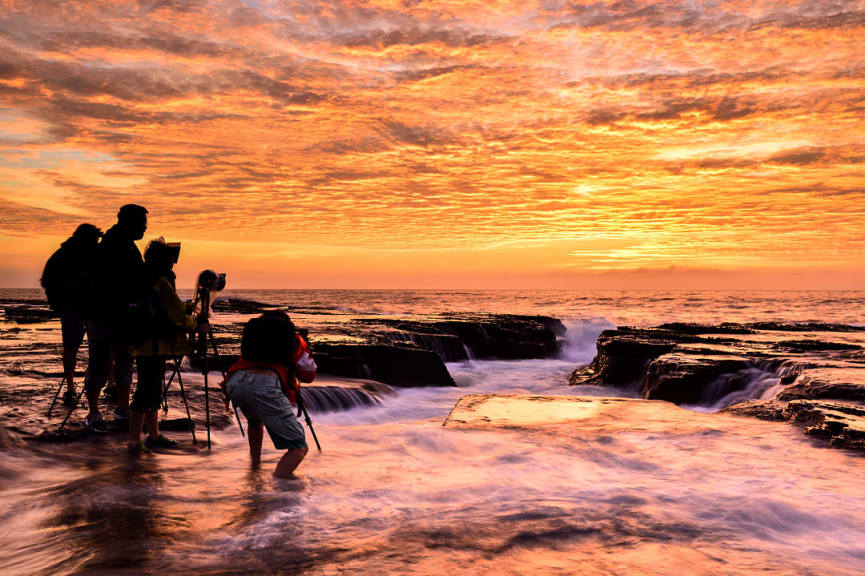
Photographers capturing sunrise on the North Narrabeen coast near Sydney, Australia
Length: 13 Days
Places Visited: Auckland, Rotorua, Queenstown, Milford Sound, Sydney, Blue Mountains, Melbourne, Uluru
Whether you are an avid photographer or a hobbyist, our meticulously crafted Photography Expedition Tour to Australia and New Zealand will take you on a dream journey through stunning landscapes and iconic sights. From the whimsical Hobbiton movie set to dramatic Milford Sound, remarkable scenes lie primed for the lens.
Balancing natural wonders like the mystic Blue Mountains and Uluru at sunrise with urban gems such as a Sydney Harbour cruise and bridge climb, the itinerary is curated to maximize lighting and perspectives so you can check off wish-list photography locales while savoring immersive cultural experiences.
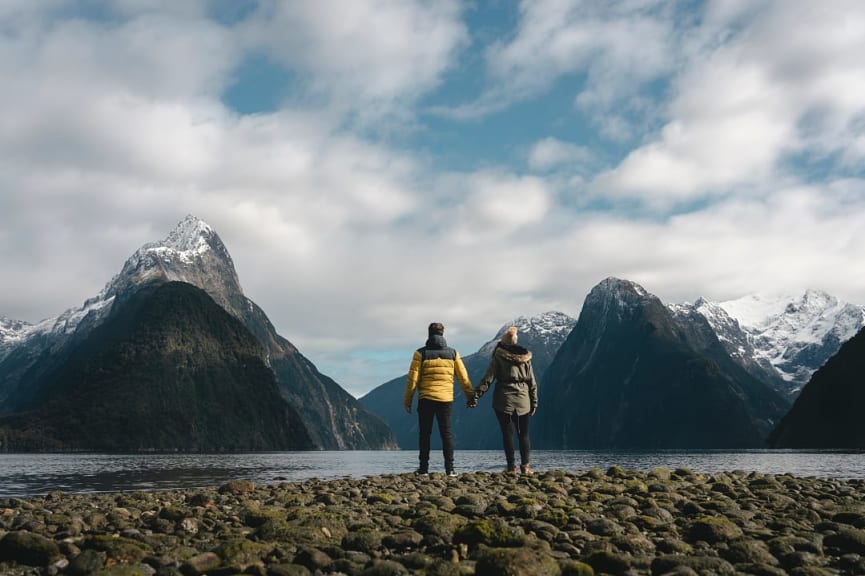
Couple at Milford Sound in New Zealand
Length: 17 Days
Places Visited: Bay of Islands, Napier, Queenstown, Fiordland National Park, Milford Sound, Sydney, Fraser Island, Melbourne, Hawke’s Bay
A Romantic Getaway Tour to New Zealand and Australia will plunge you into stunning natural landscapes and iconic experiences. As a couple, you will savor luxurious privacy sailing the azure waters of the Bay of Islands on a private yacht, helicoptering over jaw-dropping alpine vistas, and staying in a beachfront villa on Fraser Island.
Climb the Sydney Harbour Bridge and cruise misty Milford Sound with opportunities to intimately connect. Adding to the romance are indulgent treats like a wine tour through Hawke's Bay vineyards and a sunset flight over the sacred Uluru monolith.
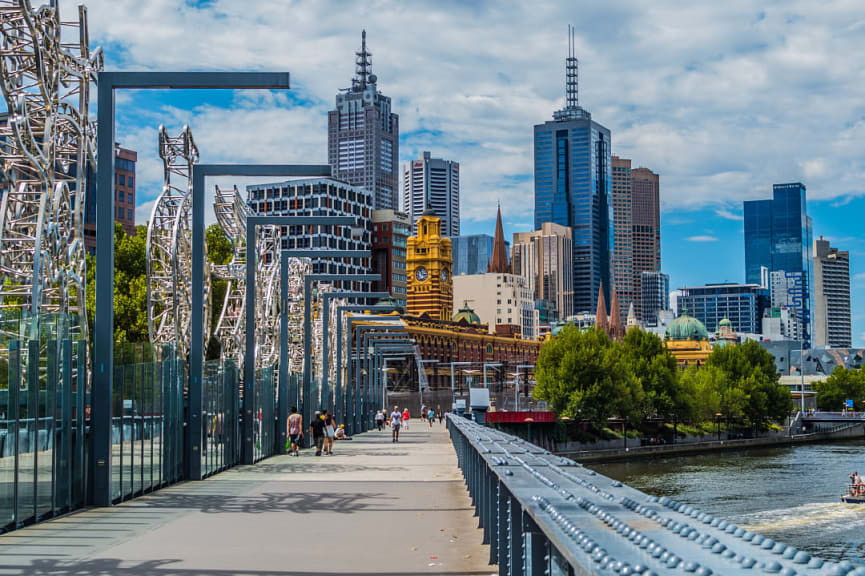
Melbourne, Australia
Length: 16 Days
Places Visited: Auckland, Rotorua, Christchurch, Greymouth, Wanaka, Milford Sound, Queenstown, Sydney, Melbourne
For an epic multi-generational adventure across the breathtaking landscapes of Australia and New Zealand, take a look at our New Zealand and Australia Tour for Families with Teenagers . The itinerary blends experiences like walking on the Franz Josef Glacier, cruising through mystic Milford Sound, and climbing the iconic Sydney Harbour Bridge. Connect with your loved ones as you explore glowworm caves, learn about traditional Māori culture, and discover locations from famous movies.
Covering the highlights of both countries, this tour will enable you to maximize your time creating unforgettable memories amidst the South Pacific's striking natural scenery, wildlife, and culture.
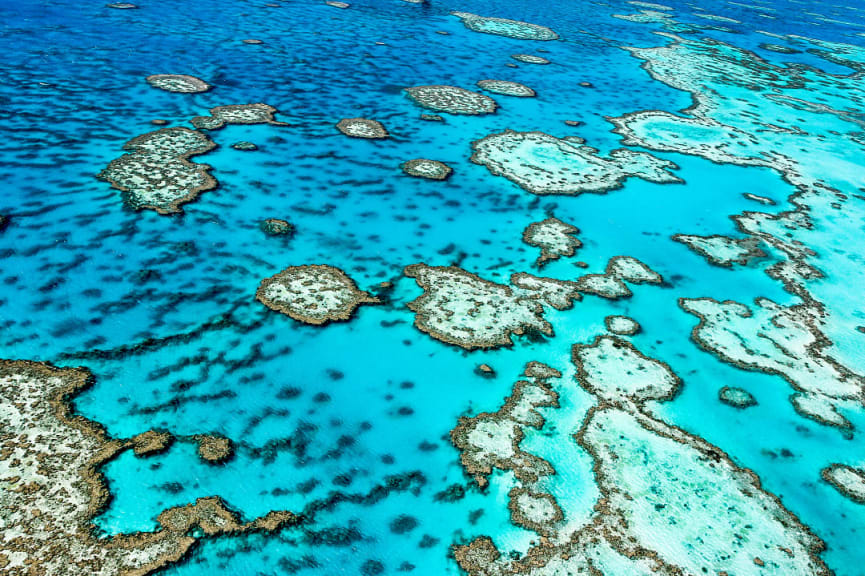
The Great Barrier Reef in Queensland, Australia
Places Visited: Melbourne, Daintree National Park, Sydney, Blenheim, Queenstown, Rotorua, Auckland, Uluru
Immerse yourself in the diverse landscapes, cultures, and experiences of the two countries with our An Eclectic Australia and New Zealand Tour: Nature, Culture, and Gastronomy as it blends iconic sights with off-the-beaten-path adventures for an enriching, multifaceted travel experience.
From the vibrant cities of Melbourne and Sydney to the otherworldly beauty of Uluru and the Great Barrier Reef in Australia, as well as the breathtaking fjords of Fiordland National Park and the rich Māori culture in New Zealand, you will experience a wide range of natural wonders and cultural highlights. Hot-air balloon over the Atherton Tablelands, whale watch in Kaikoura, and wine taste in renowned regions like Marlborough and Waiheke Island.
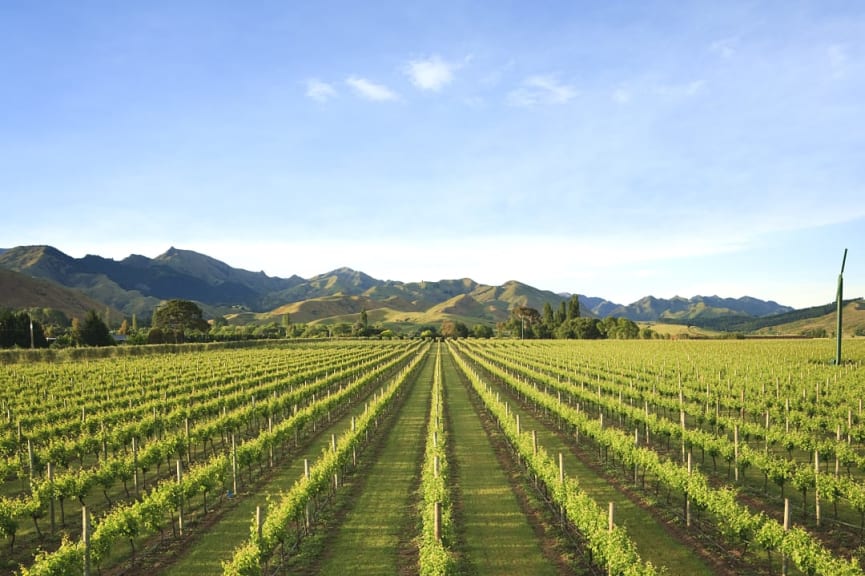
Vineyard in the Marlborough region of New Zealand's South island
No matter your interests or travel style, our Australia and New Zealand itineraries offer the perfect blend of breathtaking natural scenery, immersive cultural experiences, and luxurious comfort.
From witnessing Uluru's mystical color changes and snorkeling the vibrant Great Barrier Reef to the intimate tranquility of cruising through Milford Sound's misty fjords, each journey promises to leave you spellbound by the region's staggering beauty and rich heritage.
As you plan your trip, find more inspiration in our Australia and New Zealand travel guide or explore greater possibilities with more Australia and New Zealand Tours .
Life-Enriching Travel Designed Just for You
Trips curated by the world’s top destination experts
Concierge-level service leading up to and during your trip
Unique, exclusive experiences and insider access
Help Me Plan My Trip
Get Top Travel Specialists to Help Plan Your Trip

Entering or leaving Australia
Australia welcomes millions of overseas visitors each year. Anyone who is not an Australian citizen needs a valid visa to enter the country.
International passenger caps have been removed for all international passenger arrivals into Australia.
All travellers should be aware that: People entering Australia do not need to provide evidence of vaccination status People entering Australia do not need to complete the Digital Passenger Declaration or Maritime Travel Declaration People leaving Australia will not be asked to provide evidence of their vaccination status Unvaccinated visa holders do not need a travel exemption to travel to Australia Mask wearing on international flights to Australia is no longer mandatory . It is important to remember that airlines, vessel operators and other countries may have specific requirements that travellers need to comply with.
Australian Citizens
All Australian citizens must enter and exit Australia on an Australian passport. Your Australian passport must be valid (not expired) on the day of your arrival in Australia. It does not need to have six months remaining validity to enter Australia unless you are passing through a third country that requires it. Citizens are not entitled to a visa, even if you are also a citizen of another country. Please see the Department of Home Affairs website for more information.
Immigration and Visas
All foreign travellers, except New Zealand citizens, must obtain a visa or travel authority before travelling to Australia.
» Immigration and visas
If you have a specific question, please contact the Department of Home Affairs .
You will also need to know what you can and cannot bring into Australia, knowing the duty-free concession limits and what to experience when travelling through Australian airports and seaports.
Please visit the Department of Home Affairs website for more information.
Plan your trip with australia.com , the official Tourism Australia website, offering a wide range of travel information and planning tools including over 2000 images, a currency converter, daily weather updates, interactive maps, suggested holiday itineraries, holiday deals, specialist travel agents and more. Available in nine languages.
Tourist Refund Scheme
The Tourist Refund Scheme enables you to claim a refund, subject to certain conditions, of the goods and services tax (GST) and wine equalisation tax (WET) that you pay on goods you buy in Australia.
- Travel Updates
- Travel Stories
‘Couldn’t believe it’: Wild Macca’s goes viral
Tourists have been left stunned by a very unique McDonald’s restaurant that’s been dubbed the “coolest” in the world for one very good reason.

Americans raging over Aussie’s comments

‘Obnoxiously expensive’: Shock at Disney cost

Family’s plea after horror Bali incident
A McDonald’s in New Zealand is all rave with the fast-food restaurant dubbed the “coolest Macca’s in the world”.
Taupo, a town near the centre of NZ’ North Island, is home to the only McDonald’s location that includes a decommissioned DC3 plane as part of the store.
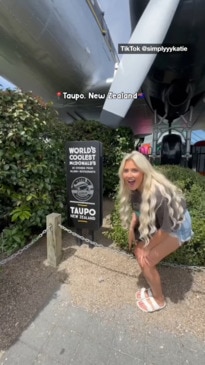
At first glance, it looks like an ordinary Macca’s store with a drive-through. However, a Douglas DC-3 aircraft is parked next to the location, painted in a dark green McDonald’s livery.
And what’s more, diners can sit inside to enjoy their meal with a view of the original cockpit.
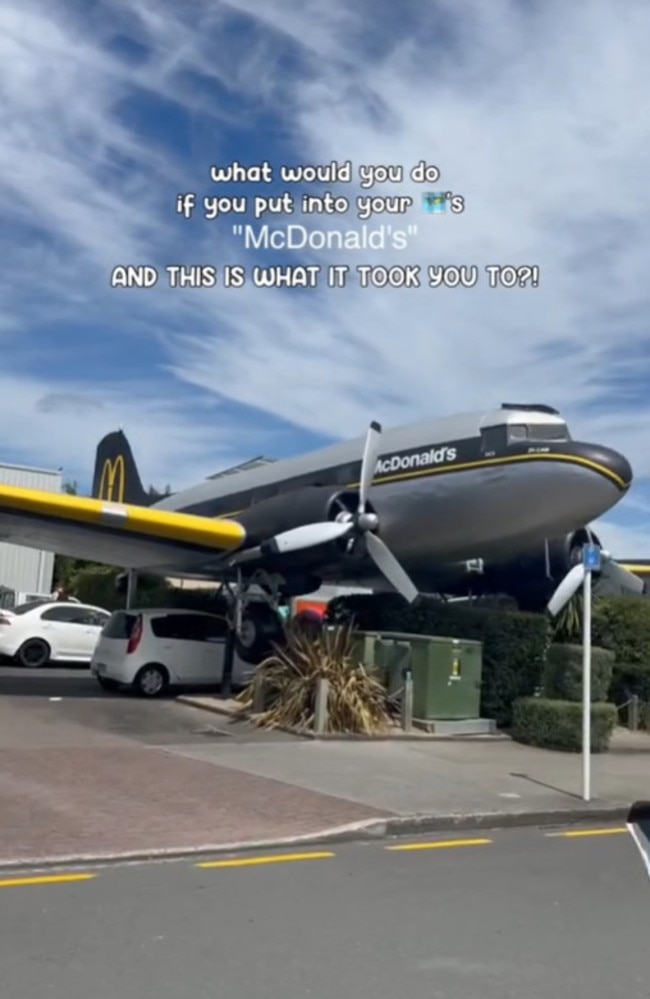
The unique Macca’s has blown tourists away with TikToks showing off the one-of-a-kind restaurant.
“What would you do if you put into your maps ‘McDonald’s’ and this is what it took you too,” British tourist and travel blogger Katie asked in TikTok showing off the plane.
“That is what happened to me. Here in Taupo, New Zealand is home to the world’s coolest McDonald’s. I couldn’t believe my eyes.”
@travelsbytash Second RTW McDonald’s review!! The coolest McDonald’s in the world 🤩 - keep watching for the actual review! #aroundtheworldtrip #mcdonaldsnewzealand #mcdonaldstastetest #mcdonaldsworldtour #coolestmcdonalds ♬ Monkeys Spinning Monkeys - Kevin MacLeod & Kevin The Monkey
Katie was eager to order her food and head inside the plane.
After using the kiosk to place her order she headed outside to the restaurant’s garden where a set of stairs took her up to the plane part of the eatery.
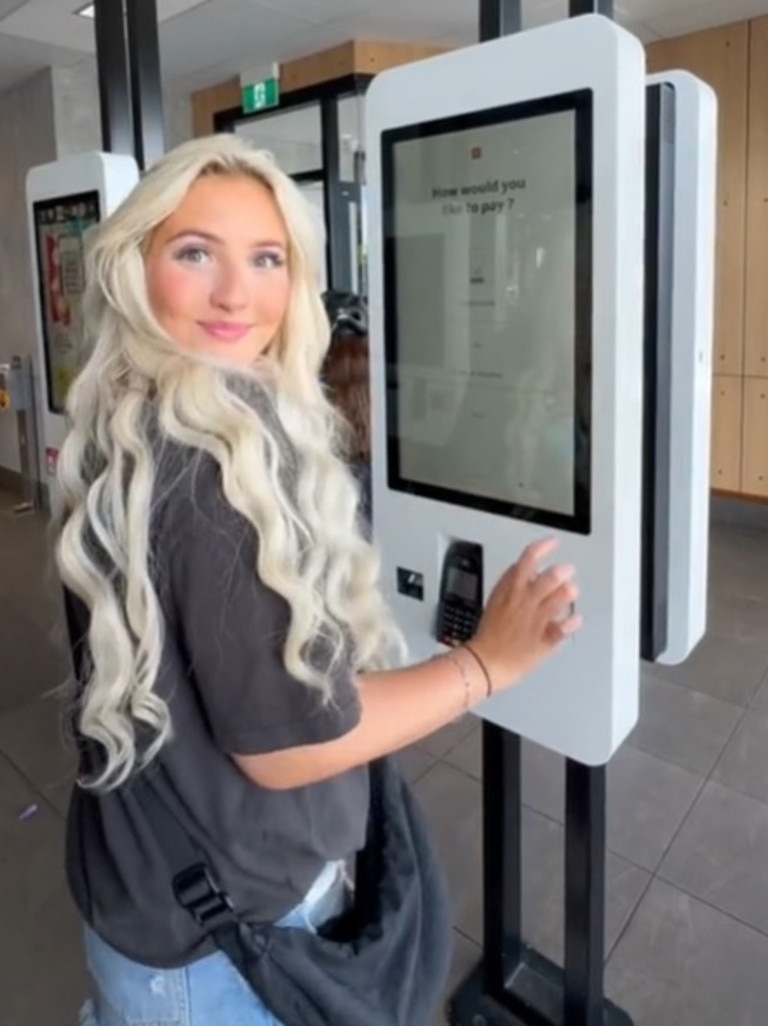
“You can sit and enjoy your ‘Maccis (sic) inside the plane. I’ve never experienced anything quite like it. And there’s even a real cockpit you can have a look at too.”
It made the “10 coolest McDonald’s around the world” list for a reason with the decommissioned DC3 plane used by South Pacific Airlines between 1961 and 1966.
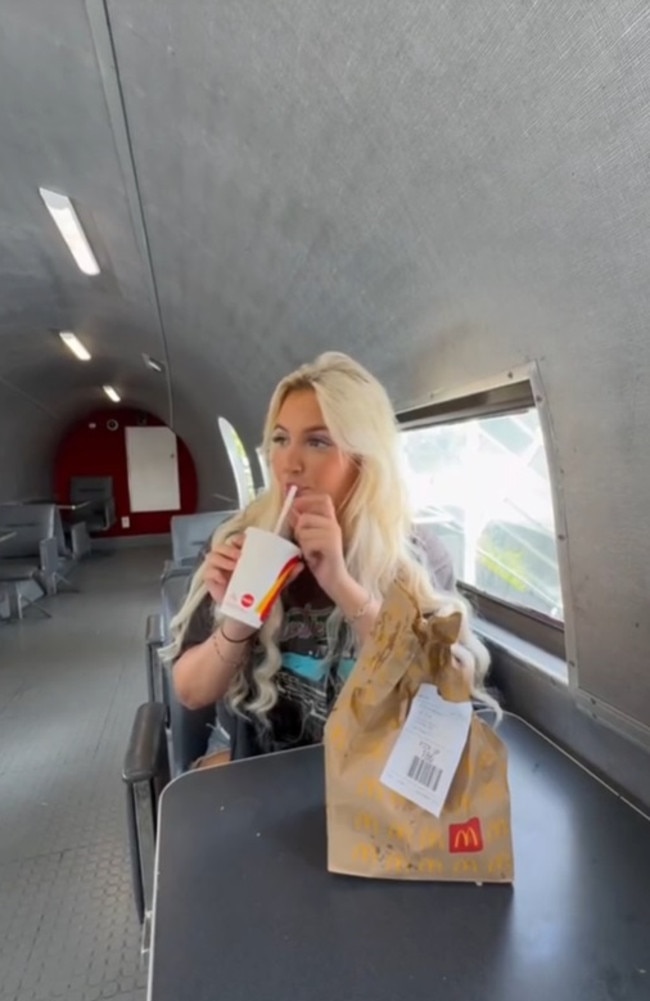
Before that it served during the Second World War. It was constructed in Long Beach, California, in 1943 as a military transport aircraft. During the war, the aircraft operated transport flights around the Southwest Pacific, according to Simple Flying .
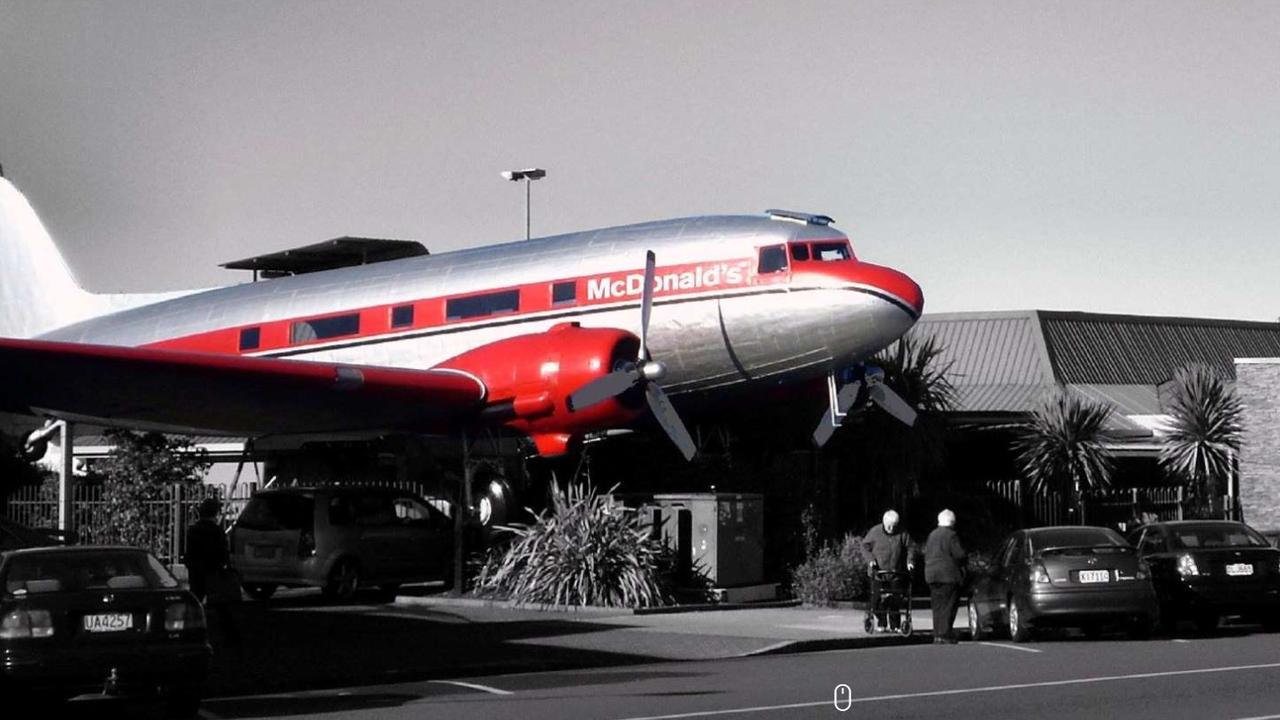
After the aircraft was surplus to the requirements of the United States Army Air Force (USAAF), it was stored in the Philippines and deleted from the Army Air Force’s inventory on the last day of 1945.
More Coverage

The publication reported that between February 1947 and October 1961, the aircraft was registered in Australia, flying for a range of now historic carriers.
And after that it was used by South Pacific Airlines of NZ. It then flew another 12 years until its bankruptcy in 1966 before making its final flight in 1984.
Now, the decommissioned DC3 plane is what makes the Taupo Macca’s the “coolest” in the world.
A lone Aussie has angered thousands of Americans after she revealed what “pisses her off” the most about people born in the US.
A man looking to take his family on a Disney World trip has expressed his shock over the cost of the stay – causing a pile on.
The family of an Australian woman who received horrific injuries in an incident in Bali is desperately trying to bring her home for medical care. Warning: Graphic content
The Straits Times
- International
- Print Edition
- news with benefits
- SPH Rewards
- STClassifieds
- Berita Harian
- Hardwarezone
- Shin Min Daily News
- Tamil Murasu
- The Business Times
- The New Paper
- Lianhe Zaobao
- Advertise with us
China offers visa exemption to Australia, New Zealand and Poland
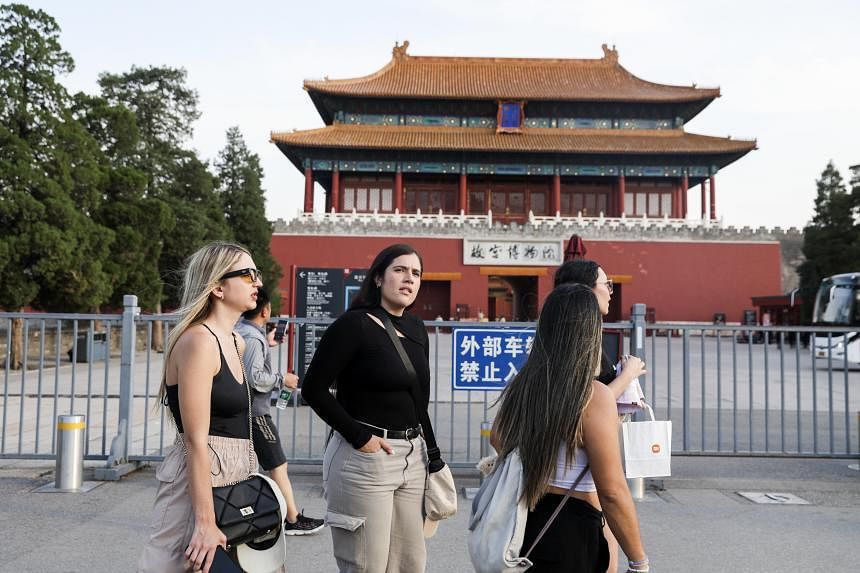
BEIJING – China said it will extend its visa-waiver programme to citizens from Australia, New Zealand and Poland in the latest sign of closer ties with the countries.
Travellers from the three nations will be able to enter China without a visa for visits of as long as 15 days, China’s Foreign Ministry said in a statement.
The exemption, which starts on July 1 and runs until the end of 2025, can be used for business trips, tourism and visits to relatives and friends, the ministry said.
The easing of restrictions follows a visit by Chinese Premier Li Qiang to New Zealand and Australia in June to discuss trade and investment.
Polish President Andrzej Duda met his Chinese counterpart, Mr Xi Jinping, in Beijing on June 24.
China is willing to work with Poland and other countries to promote sustainable development and cross-country relations, China’s Foreign Ministry said. BLOOMBERG
Join ST's Telegram channel and get the latest breaking news delivered to you.
- New Zealand
Read 3 articles and stand to win rewards
Spin the wheel now

Plan & Book
Flight information, infinity mileagelands, business travel, please select your country / region of residence, travel news, eva air official website and eva mobile app maintenance announcement.
Jul 1, 2024
To enhance the quality of service on EVA Air official website and mobile App, maintenance will be conducted on July 9, 2024 00:30–04:00AM (Taipei time, GMT +8). During this period, some functions and services will temporarily be unavailable.
We apologize for any inconvenience that we might cause.
This site uses cookies.
EVA Air's websites use cookies and similar technologies for the best experience on our website, including personalized services, ads and traffic analysis. These cookies include targeted media cookies and advanced analytics cookies. By clicking on "Accept", you agree to the use of cookies. You can change your cookie preference by clicking on the "Change your cookie settings" button.
For more detailed information on the cookies we use, please check our Cookie Policy .
Essential cookies are essential for the operation of our website that will let you move around our website freely and use functions on the websites. These cookies don’t gather your personal identifiable information that could be used for marketing and are not disclosed to any third party.
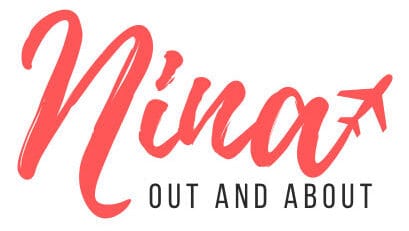
Nina Out and About contains affiliate links and is a member of the Amazon Services LLC Associates Program. If you make a purchase using one of these Amazon links, I may receive compensation at no extra cost to you. See my Disclosure Policy for more information.
How to Get From Australia to New Zealand: 3 Best Ways
Table of Contents
New Zealand is a very popular destination for those living in Australia and is also frequently visited by travellers who come to Australia, as they are so close in proximity to one another.
Since this is a frequently travelled route, it is important to check out this guide to help you plan every aspect of your trip , from the best sites to see to the best way to get around New Zealand. You’ll even learn where to park when visiting New Zealand from Australia !
Read on to learn everything you need to know about travelling from Australia to New Zealand !
Find the cheapest flights to New Zealand here !
Flying to New Zealand

Australia to NZ Flights
The cheapest and easiest way to get from Sydney to New Zealand is to fly.
The cost of Australia to NZ flights is an average of around $600, with the cheapest flight being around $150.
The flight takes about 6 hours and 10 minutes.
It is also important to keep in mind that New Zealand is 2h ahead of Sydney once you arrive.
Flights depart daily from Sydney Airport as well as airports in Adelaide, Brisbane, Melbourne, and Perth.
Sydney International Airport is the largest in Australia, and all the major airlines serve it. Only eight km from Sydney city center, the airport is accessible by taxi, shuttle, or ride-share services. You can also take the train link that is conveniently located at the northern end of the terminal.
Melbourne International Airport is the second largest airport in Australia and offers daily service to New Zealand as well.
The flight times for all airports vary from 3 to 6 hours.
Which airlines fly directly from Australia to New Zealand?
Many international carriers fly from Sydney International Airport to Auckland International Airport each day, including Air New Zealand, Qantas, Jetstar, Singapore Airlines, Virgin Australia, Emirates, and Cathay Pacific.
Christchurch International Airport is also a hub with direct routes from Australia on the same airlines.
For those who are living in Australia, if you are planning on driving to the airport and leaving your vehicle while you are visiting New Zealand , then check out Flyparks.
Flyparks is an online comparison site for parking at airports across New Zealand and Australia. So if you are looking to save on parking at Sydney, Brisbane, or even Melbourne Airport Parking , then explore their site for the best rates.
When to Travel to New Zealand?
If you are looking to visit New Zealand , then booking your trip for May might be the best option.
The reason for this is that May is one of the best times to fly to New Zealand from Australia because the cost of flights is very inexpensive. The most expensive ticket prices can be found in the month of December – summer in New Zealand and the height of the tourist season.
May is also the last month of Autumn in New Zealand and is especially the best time to visit New Zealand South Island, where you can see all the beautiful nature and fall leaves, with less of a crowd.
Thus, May just might be the best time for your next trip to New Zealand.
New Zealand Travel Visas from Australia
If you are travelling from Australia and have an Australian passpower, then you do not need a visa or the NZeTA to enter New Zealand.
If you are a permanent resident of Australia or you are a resident with a valid return visa, you will need to request a NZeTA. The same applies to UK residents, who are allowed to visit New Zealand without a visa for 6 months, but still need to fill out the NZeTA.
Similarly, for Canadians and Americans , you do not need a travel visa to visit New Zealand. You’ll just need a return ticket to show that you are leaving the country within the required period.
The NZeTA is the New Zealand Electronic Travel Authority and is for those who are visiting New Zealand who can travel there without first applying for a visa.
Getting Around New Zealand
There are many ways to travel throughout New Zealand and they depend on your budget , how many people you are travelling with, and what your travel goals are.
Below are the best ways to get around New Zealand with some extra tips included!
Travel New Zealand by Plane
Since New Zealand is so big and the largest cities are so spread out, flying can be a great option to get from place to place. Also, if you want to pair flying with driving, that is also an excellent option to see as much of the country as possible.
If you fly into Auckland International Airport and rent a car to explore for a few days, you can then return to the airport and fly out to Christchurch for your next adventure.
You can always utilize Auckland Airport Parking so that you can leave your car in a safe, secured location while you are off exploring New Zealand.
Search for flights to New Zealand now!
Travel New Zealand by Car/Van
Traveling Australia by car is one of the best options you have for seeing the country! This option can also be the most cost-effective as well.
If you select the campervan option then you can make use of campgrounds and park facilities that can help you save on accommodation costs.
While New Zealand is very large, travelling by car allows you to see as much as possible and explore the areas of the country that are not always seen by tourists.
I recommend using Discover Cars to quickly compare rental options.
Travel New Zealand by Bus
Travelling through New Zealand by bus is a great way to travel and meet other people , while also saving on some costs.
It is also a great way to sit back and relax while you get to simultaneously sightsee the beautiful nature throughout New Zealand.
There are lots of companies that have a hop-on hop-off package and also other companies drive passengers to the main tourist attractions on both islands.
Check out Kiwi Experience’s tours!
Thus, this is a great option for seeing New Zealand without having to do all the planning and driving yourself!
Best places to visit in New Zealand
New Zealand is known for the exceptional beauty and breathtaking nature that encompasses the country.
Below you can find a list of the top nature destinations to visit on your next vacation to New Zealand.

Fiordland National Park
Fiordland is the largest nature park in all of New Zealand and is also a World Heritage Site.
This national park is located on the South Island of New Zealand. This nature park also has hiking, waterfalls, rivers and forests to explore as well.
In addition, you can find tons of flora and fauna that are native to New Zealand, such as kiwibirds.
If you are interested in facts about New Zealand , the kiwi is not just a fruit but also the national animal, which is how they got the nickname!

Abel Tasman National Park
In contrast to the previous national park, Abel Tasman National Park is the smallest national park in New Zealand.
Don’t let the small size discourage you though, because this nature park is one of the most beautiful sights in all of New Zealand!

Lake Tekapo
Lake Tekapo is located in the Mackenzie Basin in the middle of New Zealand’s South Island, between Christchurch and Queenstown .
If you are travelling down to Christchurch to explore other parts of New Zealand, then you can leave your vehicle with Christchurch Airport Parking so that you don’t have to worry about your vehicle while you are off exploring.
This lake is one of the most famous lakes in all of New Zealand and is known for its incredible turquoise colored water. This beautiful water is surrounded by high mountains that turn into snow-covered mountains in the winters.
At this lake you can swim, kayak, hike the nearby mountains, and even stargaze, since this location is one of five designated international dark sky reserves in the world.

Tongariro National Park
Lastly, we have Tongariro National Park , which is New Zealand’s oldest National Park, established in 1887, and is a world heritage site as well.
Located only a four-hour drive from Auckland, is home to three active volcanic mountains, Ruapehu, Ngauruhoe and Tongariro, and is also a site of Maori cultural and spiritual associations.
Tongariro National Park has countless activities and sites to see including intense hikes, snow-capped peaks, bright blue lakes, and even hot springs.
So if you are looking for the adventure of a lifetime, then add Tongariro to your list as a perfect day trip from Auckland.
Wrap Up: Travelling from Australia to New Zealand
Overall, I hope that you can see how New Zealand is definitely a must-visit location. There are countless beautiful cities and natural parks to visit in New Zealand that will ensure your trip is full of adventure and one that you will never forget.
The author of this article is Sarah Sheedy and she works for Flyparks.com.au . Flyparks is an online comparison site for airport parking that helps customers find budget options at airports across Australia and New Zealand.
Related Posts:
- The Ultimate New Zealand Bucket List: 79 Unique Things to Do
- 17 Best Places to Visit & Top Things to Do In North Island New Zealand
- 18 Places to Visit & Top Things to Do In South Island of New Zealand
- Is Sydney safe for solo female travellers?
- 101 New Zealand Fun Facts To Know Before You Go
Pin this for later!

Living Abroad Travel Planning Guide
🚑 Should I buy expat travel insurance?
100% YES! — With basic coverage averaging just $5-10 USD per day, enjoy peace of mind with a plan from Safety Wing!
🌎 What is the best country to live in as an expat?
It depends – the best country to live in as an expat will depend on your unique needs. I developed this free quiz to help you figure out where is right for you!
📍 How do I pick a country to live abroad?
It depends – picking a country to live in is hard. That’s why I developed this $7 course to share all of the steps I’ve taken when deciding to move to 20+ different countries, and how I handle homesickness when I get there.
Ultimately, making the choice of where to move is going to be hard. But the hardest thing is deciding to move abroad at all!
💼 How do I get a job as an expat?
You can find work abroad via local job boards or temp agencies. My favourite way to work is remotely, so I always look for jobs on FlexJobs.com when I live abroad. They hire for 100% remote roles only.
If you’re looking to teach English abroad, Premier TEFL has the best online course to get you great work!
💰 How do I open a bank account abroad?
Wise.com offers free global accounts, and the cheapest money transfers. Since it can be a headache to open bank accounts in different countries (it took me 2 months in the UK!), Wise.com is a great solution.
I actually use it as my primary bank now worldwide due to the multi-currency debit card. ( Read more )
👯♀️ How do you make friends abroad?
Meetup.com – Meet likeminded people who share a similar hobby with Meetup! It’s free to join, but some activities may cost money, like if you go to a cafe and get a coffee.
🙀 I don’t speak the language. Can I still live abroad?
Learn languages in no time with iTalki ! Moving abroad is an opportunity to learn the language. You don’t need to know it before you leave home.
💻 Do I need a VPN?
Yes! – VPNs allow you to access more of the internet. From US Netflix in the UK to social media sites banned in Asia. It’s a really helpful and cheap thing to ensure your online activities aren’t restricted.
🧳 What’s the best luggage for living abroad?
This is my favourite luggage set f or long term travel. You can read more about my review of types of suitcases for travel here .
🏡 How do I tell my friends and family I want to live abroad?
Take this $7 course and learn the exact script I used to tell my family I was moving abroad … and then when I did it again. I even include tips for prepping your family, and for how to handle family who aren’t supportive.
✈️ What’s the best site to buy cheap flights?
To find cheap flights, I recommend Skyscanner . ( Read more )
🏨 What’s the best site to find cheap hotels?
To find cheap hotels, I recommend Booking.com . ( Read more )
Or stay for free with Trusted Housesitters!
🚗 What’s the best site to rent cars abroad?
To find cheap rental cars, I recommend Discover Cars .
🚗 What’s the best site to find tours?
To find epic tours, I recommend Viator .
Nina Clapperton is the founder of Nina Out and About. She has lived in 18 countries in the past 10 years, explored more than 30 countries, and has done most of it solo. A Canadian native, she also shares her favourite things to do in the True North. She helps over 100,000 people per month plan their expat adventures and Canadian trips.
Want to move abroad, but don’t know how to start?
Get an expert’s tips & tricks, pick which country to move to – and do it.
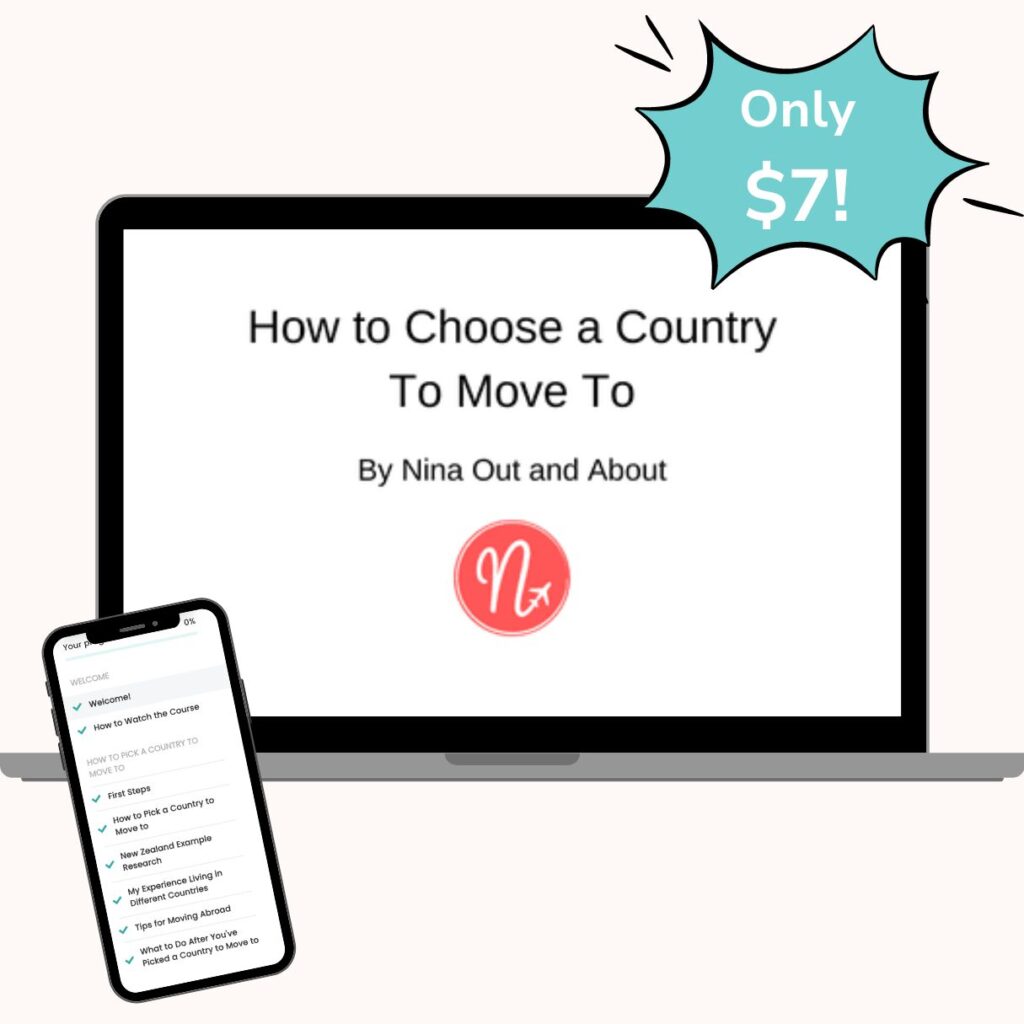

New Zealand – step by step guide for cats and dogs
Cats and dogs coming to Australia from New Zealand do not require an import permit. There is no Australian post entry quarantine period.
Cats and dogs coming to Australia from New Zealand do not require an import permit however, import conditions apply.
- The conditions on the required health certification take precedence over any other source of information. This step-by-step guide explains what you must do to prepare your animal for export; it is not a substitute for the health certification.
- Cats and dogs must comply with all conditions on the health certification.
- moved to and held in post entry quarantine
- subject to additional testing
- A registered veterinarian must perform all veterinary procedures listed below.
- There is no mandatory quarantine period for cats and dogs from New Zealand.
Step 1: Contact the New Zealand Ministry for Primary Industries Timeframe: Before starting the export process
Contact the New Zealand Ministry for Primary Industries to find out:
- which veterinarians and laboratories are approved to prepare your cat or dog for export
- if New Zealand has any requirements in addition to those stated on this webpage
The department recommends that you take this information to your government approved veterinarian or pet transport agent to help you understand the requirements.
Step 2: General eligibility
- Cats and dogs must have been continuously resident in New Zealand since birth or direct importation from Australia or for 180 days immediately before the date of export if it has been imported into New Zealand from any other country.
- Cats and dogs must not be under quarantine restrictions at the time of export.
- Cats and dogs must not be more than 40 days pregnant nor be suckling young at the time of export.
- Cats and dogs must be at least eight (8) weeks old at the time of export.
- Microchip numbers starting with 999 are not acceptable because they are not unique.
- Savannah cat, domestic cat ( Felis catus ) crossed with serval cat ( Felis serval )
- Safari cat, domestic cat crossed with Geoffroy cat ( Oncifelis geoffroyi )
- Chausie, domestic cat crossed with Jungle cat ( Felis chaus )
- Bengal cat, domestic cat crossed with Asian leopard cat ( Prionailurus bengalensis ).
Note – in certain circumstances, the Department may permit the import of Bengal cats that are five generations or more removed from their wild ancestor. If you plan to import a Bengal cat, please contact Department of Climate Change, Energy, the Environment and Water at [email protected] to confirm your cat satisfies the requirements before you apply for an import permit.
- Czechoslovakian wolfdog or Czechoslovakian Vlcak
- Saarloos wolfdog or Saarloos wolfhound
- Lupo Italiano or Italian wolfdog
- Kunming wolfdog or Kunming dog.
Please contact the Department of Climate Change, Energy, the Environment and Water at [email protected] for more information on hybrid animals and reproductive material/specimens.
- dogo Argentino
- fila Brasileiro
- Japanese Tosa
- Pit Bull Terrier or American Pit Bull
- Perro de Presa Canario or Presa Canario.
For more information on prohibited dog breeds, contact the Department of Home Affairs on +61 2 6264 1111 or 131 881 (within Australia).
Step 3: Permission to import
An import permit is not required.
The exporter must sign a Statutory Declaration that:
- identifies the cat/dog by breed, sex, age and microchip number
- verifies that the cat/dog has been continually resident in New Zealand since birth or direct importation from Australia, or for the 180 days immediately before the date of export if the animal has been imported into New Zealand from any other country
- verifies that the cat/dog is not derived from a domestic/non-domestic hybrid and that a dog is not a prohibited breed
- verifies that if a female cat or dog, the animal is not more than 40 days pregnant or suckling young at the time of export
- states whether the dog has ever been to mainland Africa.
Step 4: Health certificate requirements
The animal must be accompanied by a health certificate agreed between Australia and the New Zealand Ministry for Primary Industries . The health certificate must be an original document, and copies will not be accepted.
The health certificate must certify that:
- the animal has been identified by a microchip
- New Zealand is free from rabies
- the animal was examined within five (5) days before the date export and found to be fit to travel
- the animal was treated for external and internal parasites within five (5) days before the date of export.
There are two versions of health certificates which may be issued for animals exported from New Zealand to Australia:
- A pre-printed export certificate (AUPET9) completed and issued by a Private Veterinarian designated by the Ministry for Primary Industries
- An official assurance certificate (AUPETOA9) completed and issued by a Ministry for Primary Industries Official Veterinarian
Check the New Zealand Ministry for Primary Industries’ Cats and Dogs to Australia Overseas Market Access Requirements (OMAR) and website to determine which type of health certificate your pet requires for import to, or travel via, Australia.
The health certificate must also certify that:
- canine brucellosis ( Brucella canis ), leptospirosis ( Leptospira canicola ) and leishmaniosis ( Leishmania infantum ) have not been confirmed in New Zealand during the 12 months before the date of export
- a negative test result (IFAT or ELISA) for Leishmania infantum.
These tests must be done after the dog has resided in New Zealand for a minimum of 21 days. This testing remains valid only if the dog is continuously resident in New Zealand from the sampling date until export to Australia.
Dogs that have ever been to mainland Africa must be treated by a government approved veterinarian while resident in New Zealand for Babesia canis with imidocarb dipropionate either:
- as one treatment at 7.5 mg/kg bodyweight via subcutaneous or intramuscular injection OR
- two treatments at 6 mg/kg bodyweight via subcutaneous or intramuscular injection given two weeks apart.
Where the dog is not treated in New Zealand a copy of the certification of the treatment must be endorsed by the MPI and accompany the dog to Australia.
Step 5: Travel to Australia
- The Department of Agriculture, Fisheries and Forestry does not place any restrictions on the airline you choose. However, the animal must travel as manifested cargo (not in the cabin) and in an International Air Transport Association (IATA) approved crate for cats or dog.
- The department accepts no responsibility for cats or dogs that escape en route.
- All transport costs are at the importer’s expense.
- Assistance dogs may travel with their handler in the cabin, at the discretion of the airline.
Step 6: Clearance on arrival
- All import conditions must be met, including the need for documentation to bear the original signature of a veterinarian approved by the New Zealand Ministry for Primary Industries (documents may only be endorsed following all treatments, tests and examinations)
- All health certification and relevant documentation must travel to Australia with the cat or dog.
- Notify the department at least three (3) days before the animal arrives by emailing the regional office in the state/territory in which the cat or dog will first arrive in Australia.
General inquiry: 1800 900 090 or + 61 3 8318 6700 (from outside Australia)
For more office locations visit: Office locations
- the date and estimated time of arrival
- the flight number
- the air waybill number
- a short description of your cat or dog
- a contact phone number in Australia or New Zealand
- the address at which the cat or dog will stay in Australia
- whether the dog is an assistance dog.
- Cats and dogs must be cleared at the first port of arrival in Australia.
- Allow at least one (1) hour for the cat or dog to be released by airline cargo and cleared by the department. Connecting flights must not leave within one hour of the animal arriving in Australia.
- Lack of original health certificates and related documentation will result in your pet’s clearance being delayed.
- If your cat or dog is to connect with a domestic flight you will have to arrange for it to be moved from the international to the domestic terminal. Animal transport agents/pet shippers can help you with this. The International Pet and Animal Transportation Association website has a list of pet shippers.
- You will be charged for the time taken to assess the documentation that accompanies your animal to Australia. Details of the department’s fees can be found in the charging guidelines . Please contact the relevant state/territory office to determine the fees for clearing your cat or dog.
- Fees are usually collected by the airline carrying your animal. The payment should appear on the air waybill. The department then invoices the airline to recover the fees. If the air waybill has not incorporated these fees the department will require payment before releasing your animal.
Step 7: On arrival in Australia
- A biosecurity officer will check the cat or dog to verify that all details match the import certification.
- If acceptable, the animal will be released from biosecurity control. If not, additional documents may be requested and/or the animal may be subject to treatment, export or euthanasia.
General enquiries
Call 1800 900 090
Contact us online
Report a biosecurity concern
We aren't able to respond to your individual comments or questions. To contact us directly phone us or submit an online inquiry
Please verify that you are not a robot.
Helpful tips
Here's a few useful links to help with planning your trip to Aotearoa New Zealand.
- Best things to do in the North Island
- Best things to do in the South Island
- Other Islands
- Best ways to travel around
- Calculate travel times and distances
Travelling to New Zealand
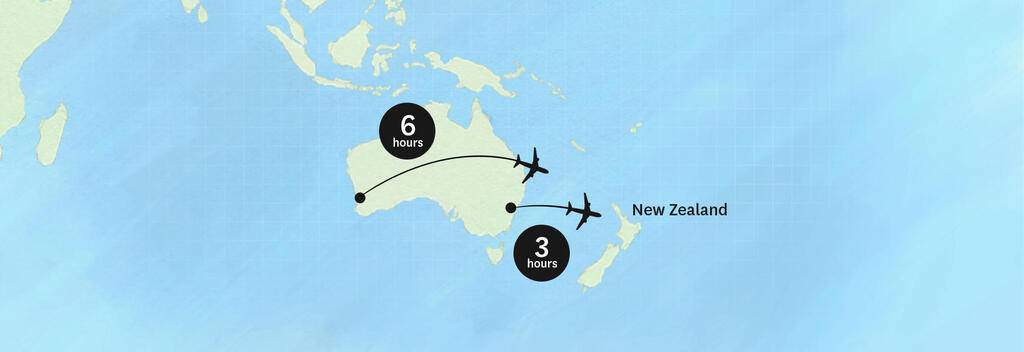
New Zealand is a short, easy flight away from Australia.
New Zealand is a short, easy flight away from Australia
See travel requirements to NZ >
Direct flights to New Zealand from Australia depart from Sydney, Brisbane, Melbourne, Perth, Adelaide, Sunshine Coast and the Gold Coast.
Many of these flights land in Auckland and other popular arrival locations include Wellington, Christchurch and Queenstown. Domestic services connect Auckland airport with a number of other airports in New Zealand.
Cruising is another popular way to get to, and explore, the country. Cruises to New Zealand from Australia depart from various locations in Australia such as Adelaide, Brisbane, Fremantle, Melbourne Sydney, and Cairns. There are also cruises from the Pacific Islands and some are round-the-world journeys.
Need help to plan your holiday? Contact a Travel Agent .
Travel requirements to New Zealand
Find out more about what you need to enter New Zealand from your country of origin, including regulations, visa requirements and health and safety guidelines.
Travellers currently need to fill in a paper Passenger Arrival Card, which is handed out onboard your flight to New Zealand.
From July 2023, travellers arriving at selected international airports in New Zealand will be able to complete an online declaration. (opens in new window)
- Travellers arriving into Christchurch airport or Wellington airport will be able to complete an online declaration from the week starting 10 July 2023.
- Travellers arriving into Queenstown airport will be able to complete an online declaration from mid to late July.
- Travellers arriving into Auckland airport will be able to complete an online declaration later in August 2023.
The Passenger Arrival Card will continue to be accepted for a period of time after the NZTD is introduced.
Essential travel information
Covid-19 travel safety information, visas and entry requirements, flights to new zealand, plane find & book flights.
Your browser does not support iframes. Find airfares
Image information Find a travel agency
- Share on Facebook
- Share by email
- Share full article
Advertisement
Australia Letter
Australian author’s novel-turned-film goes global.
Lily Brett’s delight is bittersweet as “Too Many Men,” her story about traveling with her father, becomes a movie he did not live to see.

By Julia Bergin
The Australia Letter is a weekly newsletter from our Australia bureau. This week’s issue is written by Julia Bergin, a reporter based in the Northern Territory.
On a film set in Berlin, Lily Brett cried as she watched the novel she’d written about her father come to cinematic life. Stephen Fry was essentially playing her father; Lena Dunham played the character Ms. Brett had based on herself.
“Stephen looked so like my dad. Which is just phenomenal, because Stephen is 6-foot-5 and my father at his peak was 5-10,” she said.
The film, “Treasure,” premieres in Melbourne in a few weeks. Based on Ms. Brett’s 1999 autobiographical novel “Too Many Men,” it tells the story of Edek, a Holocaust survivor, and Ruth, his daughter, on a journey to Poland, where Edek was born.
Ms. Brett says the adaptation, directed by Julia von Heinz, is true to her book and its main characters — versions of her father, Max Brett, who died in 2018 just shy of his 102nd birthday, and herself.
“When Lena did some of the weirder things that my character was required to do, all I could think of was, ‘Oh my God, did I do that?’” she groaned, recounting a scene in which her character sits down at the breakfast table and pulls out container after container of dried food. “Oh no, I did do that. Why did I do that?”
Ms. Brett’s true tales of traveling Tupperware include a customs delay in Vienna.
Officials there were so concerned about the shriveled orange sticks she’d packed in clear plastic boxes that someone from her publishing company was summoned to the airport to explain that they were, in fact, dried carrots cut into absurdly thin slices.
“I was carrying five pounds of dried carrots for a three-week book tour,” she said incredulously. “The two customs guys just looked at the woman from my publishing company and said almost simultaneously, ‘Does she think that we don’t have any carrots in Vienna?’”
The film is full of similar moments that bring her story to life, says Ms. Brett, 77, the author of six novels, seven books of poetry and three collections of essays.
From the outset, Ms. Brett’s attitude was that it wasn’t her movie — “It was Julia’s movie, it was the actors’ movie” — but she considers herself “incredibly lucky” that she was included in round after round of script writing and production, and that the film turned out as well as it did.
One thing missing from the film version, however, is the Australian connection.
After World War II, Ms. Brett’s parents left Poland and built a life for their family in suburban Melbourne. Until she started school, Ms. Brett genuinely believed she lived in a country called Paradise, because that was what her father always called Australia. As an adult, she moved to New York, and a plan for six months there turned into 35 years.
Ms. Brett had been to Poland but had never been able to persuade her father, a survivor of Auschwitz, to accompany her. But finally, he agreed to go.
The opening scene of the film is set in Warsaw, at the airport, where a stressed Ruth sternly tells her father to stand still and not wander off.
Edek’s character seems at ease, talking to anyone and everyone in Polish — just as he did when Ms. Brett traveled with him in Poland in the early 1990s.
“He talked to every single taxi driver about their car, which were mostly Mercedes,” she said. Although he immediately appeared comfortable, she could tell he was at the same time deeply troubled to be back in Poland.
In the film, that manifests as a constant mission to divert his daughter’s carefully planned itinerary. He insists on taxis instead of trains, takes her to an unremarkable crumbling brick wall rather than the ruins she’s hoping to see, and waits in the car while she looks around his old factory and home on her own. All the while, he tells everyone he meets that this is his “famous journalist” daughter.
Now, as she stands on red carpets for the premieres of “Treasure” in places like Berlin and New York, Ms. Brett said her father would have been “thrilled” (and a “hilarious nightmare”) had he been there by her side.
Ms. Brett said she’d received messages from friends and family around the world saying that the film had made them feel as if they’d spent an evening with her father.
“Dad would have loved it,” she said. “He believed that every novel I wrote was about him. Sometimes I had to remind him that he didn’t, for example, marry a big-busted blonde and open a meatball shop. He just said, ‘Ahhh, maybe.’”
Here are this week’s stories.
Australia and New Zealand
A Wish From All Sides to Move On Ends With Liberty for Assange . The WikiLeaks founder spent years in captivity in London before talks accelerated this spring, allowing him to go home to Australia as a felon, but a free man.
The Digital World Is a Powder Keg. Julian Assange Lit the Fuse . In his brazen quest for total transparency, the WikiLeaks founder paved the way for a world in which no secret is safe and no institution trusted.
Around The Times
How Science Went to the Dogs (and Cats) . Pets were once dismissed as trivial scientific subjects. Today, companion animal science is hot.
Two Kings Battle for a Millennium-Old Throne in Nigeria . Two men claim to be the emir of Kano, an ancient kingdom in northern Nigeria. Their struggle for power and influence is feeding into a wider competition ahead of the country’s next election.
Time Traveling Through London With an Impressionist Painter . A writer used Camille Pissarro’s paintings of suburban London and a “lost” railway as a lens for exploring the city’s history — and settling an arcane mystery.
Why We Still Want to Hear the ‘Ode to Joy,’ 200 Years Later . Beethoven’s aspirational vision of unity and peace can be applied to virtually any situation or place. The music makes sure of that.
Are you enjoying our Australia bureau dispatches? Tell us what you think at [email protected] .
Like this email? Forward it to your friends (they could use a little fresh perspective, right?) and let them know they can sign up here .

IMAGES
VIDEO
COMMENTS
Queenstown. You have lots of options for flying between and Australia and New Zealand. Flight times are relatively short (it's three hours from Sydney to Auckland, the same amount of time it takes to fly from Sydney to Uluru). You're not restricted to the major gateway cities of Auckland, Sydney, Queenstown and Melbourne, either.
Crime rates are similar to those in Australia. Thieves often target vehicles. Don't leave valuables in your car or campervan. Earthquakes are a constant risk. Large, damaging quakes can happen at any time. Know what to do during and after an earthquake. All of New Zealand's coastline is at risk of a tsunami.
Introducing New Zealand. 2. It's okay to dress down. Casualness rules in New Zealand, even in urban areas. Depending on what region you're in, even a wedding might see some Kiwis in jeans, their cleanest bush shirt (a tough woolen shirt) and gumboots (rubber boots) or jandals (flip flops). This is unremarkable.
I will say that New Zealand's small size makes for easier and less carbon-intensive trips within the country. Yet across its great girth, Australia is blessed with astounding and unrivaled diversity, best experienced on a road trip to destinations like Cairns and Far North Queensland, where the world's oldest living tropical rainforest meets the world's largest coral reef (the Great ...
Welcome to New Zealand. Get official travel information, maps, itineraries, activities & accommodation to help you plan your next holiday to New Zealand.
Getting around New Zealand. Whether you want to self-drive, fly, join a tour, or hop on a bus or train, there are plenty of options for getting around New Zealand. Find out what's best for you with our practical advice on travel and transport in New Zealand. Find more transport options >.
Transit in New Zealand. If you are not a New Zealand or Australian citizen, you may need to apply for a visa or a New Zealand Electronic Travel Authority (NZeTA) for transiting through New Zealand; Remember to check your final destination's entry requirements. COVID-19. Travellers do not require proof of vaccination or a pre-departure test to ...
Use this form if you are a New Zealand passport holder with criminal convictions, seeking to travel to Australia. This form will provide guidance on whether you may be considered a "behaviour concern non-citizen", which impacts your eligibility for a Special Category (subclass 444) visa (SCV). Note that the decision whether to grant a SCV ...
Build a memorable collection. Get to the heart of New Zealand with one of our in-depth, award-winning guidebooks, covering maps, itineraries, and expert guidance. New Zealand. $ 28.99. New Zealand's North Island. $ 0.0. New Zealand's South Island. $ 24.99.
COVID-19 safety practices in place. With COVID-19 case numbers falling, a highly vaccinated population, and increased access to antiviral medicines to treat COVID-19, New Zealand has removed most COVID-19 restrictions. It is still recommended to practice healthy habits when travelling around New Zealand. Practice healthy habits.
Trying to combine Australia and New Zealand in less than two weeks: Most of your time will be spent traveling rather than experiencing. If you can only get away for two weeks, don't try to cover multiple regions in each country; instead, look at combining Sydney with New Zealand, for example, or Australia with Queenstown.
Perth. Queenstown. You have lots of options for flying between and Australia and New Zealand. Flight times are relatively short (it's three hours from Sydney to Auckland, the same amount of time it takes to fly from Sydney to Uluru). You're not restricted to the major gateway cities of Auckland, Sydney, Queenstown and Melbourne, either.
The Ultimate List of New Zealand Travel Tips. Ah, New Zealand!Known to the local Māori as "Aotearoa", New Zealand is a remote country in the South Pacific famous for its dramatic scenery. At about 1,600 km (1,000 mi) long and 450 km (280 mi) at its widest point, the country is easy to explore.
The Best of Australia & New Zealand - 22 Days. View Map. Cover the spectrum of these two dynamic countries with this comprehensive itinerary. Start off in New Zealand, where you'll visit both the North and South islands to explore Maori culture, natural wonders, adventure sports, and more—sip wine on Waiheke island, hike at Aoraki, and cruise ...
New Zealanders planning to live in Australia long-term should see our Going to Australia section, and the New Zealand High Commission to Australia's Living in Australia section. New Zealanders travelling or living in Australia are encouraged to register their details with the Ministry of Foreign Affairs and Trade. Travel tips
Your eligibility to travel to New Zealand without a visa depends on the passport that you are travelling on. If you intend to travel to New Zealand on a passport issued by a visa waiver country you: may travel to New Zealand without applying for a visa first. still must get an NZeTA (New Zealand Electronic Travel Authority) before you travel.
A survey by Tourism New Zealand in mid-2021 showed that more than 80 per cent of Australians actively considering travel to the country were wanting to do so for a holiday, while 21 per cent ...
1. Oceania Trip of a Lifetime: Best Australia & New Zealand Tour. 2. Epic Highlights Tour of Australia & New Zealand. 3. An Intimate Wildlife Tour of Australia & New Zealand. 4. Photography Expedition Tour to Australia & New Zealand. 5.
All foreign travellers, except New Zealand citizens, must obtain a visa or travel authority before travelling to Australia. ... knowing the duty-free concession limits and what to experience when travelling through Australian airports and seaports. Please visit the Department of Home Affairs website for more information. Tourism.
A McDonald's in New Zealand is all rave with the fast-food restaurant dubed the "coolest Macca's in the world". More from Travel Stories 'Obnoxiously expensive': Shock at Disney cost
Aotearoa New Zealand enjoys welcoming Australian manuhiri (visitors) to our beautiful country. Having a valid passport, the right visa and completing the entry requirements are key to a trouble-free entry into New Zealand. Your passport has to be valid for at least three months beyond your intended departure date, and if required, have a valid ...
Travellers from Australia, New Zealand and Poland will be able to enter China without a visa for visits of as long as 15 days. ... China to offer visa-free travel to travellers from six countries.
To enhance the quality of service on EVA Air official website and mobile App, maintenance will be conducted on July 9, 2024 00:30-04:00AM (Taipei time, GMT +8).
Australia to NZ Flights. The cheapest and easiest way to get from Sydney to New Zealand is to fly. The cost of Australia to NZ flights is an average of around $600, with the cheapest flight being around $150. The flight takes about 6 hours and 10 minutes. It is also important to keep in mind that New Zealand is 2h ahead of Sydney once you arrive.
On 1 March 2023 we will be implementing revised import conditions for dogs and cats. The guide below reflects the revised import conditions. If your cat or dog will be imported to Australia prior to 1 March 2023 you will need to refer to your health certificate or import permit if applicable for the relevant import conditions.
New Zealand is a short, easy flight away from Australia. Direct flights to New Zealand from Australia depart from Sydney, Brisbane, Melbourne, Perth, Adelaide, Sunshine Coast and the Gold Coast. Many of these flights land in Auckland and other popular arrival locations include Wellington, Christchurch and Queenstown.
One thing missing from the film version, however, is the Australian connection. After World War II, Ms. Brett's parents left Poland and built a life for their family in suburban Melbourne.